How to determine the right size of sailboat for your needs
Choosing the right size sailboat for your sailing adventure is crucial for your comfort, safety, and overall enjoyment. Our comprehensive guide explores the factors to consider when making this important decision.

How to Determine the Right Size of Sailboat for Your Needs
Embarking on a sailing adventure with your family is an exciting and life-changing decision. One of the most important aspects of this journey is choosing the right sailboat to suit your needs. The size of your sailboat will have a significant impact on your comfort, safety, and overall enjoyment of your new lifestyle. In this comprehensive guide, we will explore the factors to consider when determining the right size of sailboat for your needs, as well as provide some tips and advice to help you make the best decision for your family.
Table of Contents
Understanding sailboat sizes, sailing experience, intended use, number of crew members, comfort and amenities, storage and maintenance, small sailboats (20-30 feet), medium sailboats (30-40 feet), large sailboats (40-50 feet), extra-large sailboats (50+ feet).
Sailboats come in a wide range of sizes, typically measured in feet from bow to stern (the front to the back of the boat). The size of a sailboat can greatly influence its performance, handling, and the level of comfort it provides. Generally, larger sailboats offer more living space, storage, and amenities, while smaller sailboats are easier to handle, maintain, and store.
Factors to Consider When Choosing a Sailboat Size
When determining the right size of sailboat for your needs, there are several factors to consider. These include your budget, sailing experience, intended use, number of crew members, comfort and amenities, and storage and maintenance requirements.
Your budget will play a significant role in determining the size of the sailboat you can afford. Larger sailboats tend to be more expensive, both in terms of initial purchase price and ongoing costs such as maintenance, insurance, and mooring fees. It’s essential to consider not only the upfront cost of the boat but also the long-term expenses associated with owning and operating a sailboat of that size.
Your level of sailing experience will also influence the size of the sailboat that’s right for you. Smaller sailboats are generally easier to handle and maneuver, making them more suitable for beginners or those with limited sailing experience. Larger sailboats can be more challenging to sail and may require a higher level of skill and experience to operate safely and efficiently.
The intended use of your sailboat will also play a significant role in determining the right size for your needs. If you plan to use your sailboat primarily for day sailing or weekend trips, a smaller boat may be more suitable. However, if you intend to embark on long-term cruising or live aboard your sailboat full-time, a larger boat with more living space and amenities will likely be more appropriate.
The number of people who will regularly be on board your sailboat is another important factor to consider. A larger boat will provide more space and comfort for a larger crew, while a smaller boat may be more manageable for a solo sailor or a couple. It’s essential to strike a balance between having enough space for everyone on board while still maintaining a manageable size for sailing and handling.
The level of comfort and amenities you desire on your sailboat will also influence the size of the boat you choose. Larger sailboats typically offer more living space, private cabins, and additional amenities such as a larger galley (kitchen), separate shower and toilet facilities, and more storage space. Smaller sailboats may have more limited amenities and living space, which may be a trade-off you’re willing to make for easier handling and lower costs.
Finally, consider the storage and maintenance requirements of the sailboat size you’re considering. Larger sailboats will require more space for storage, both on land and in the water, and may have higher maintenance costs due to their size and complexity. Smaller sailboats are generally easier to store and maintain, which can be an important consideration if you have limited storage space or a tight budget.
Popular Sailboat Sizes and Their Advantages
Now that we’ve discussed the factors to consider when choosing a sailboat size, let’s explore some popular sailboat size categories and their advantages.
Small sailboats are ideal for those new to sailing or with limited experience. They are easier to handle, more affordable, and require less maintenance than larger boats. Small sailboats are perfect for day sailing, weekend trips, or coastal cruising. However, they may lack the space and amenities desired for long-term cruising or living aboard.
Advantages of small sailboats:
- Easier to handle and maneuver
- More affordable upfront and ongoing costs
- Lower maintenance requirements
- Suitable for day sailing, weekend trips, and coastal cruising
Medium-sized sailboats offer a balance between the ease of handling of smaller boats and the increased space and amenities of larger boats. They are suitable for more experienced sailors and can be used for extended cruising or living aboard. Medium sailboats provide more living space, storage, and amenities than small sailboats, making them a popular choice for families or those planning longer sailing adventures.
Advantages of medium sailboats:
- Good balance between handling and space/amenities
- Suitable for extended cruising or living aboard
- More living space, storage, and amenities than small sailboats
- Popular choice for families or those planning longer sailing adventures
Large sailboats offer even more space, comfort, and amenities, making them ideal for long-term cruising or living aboard. They are best suited for experienced sailors, as they can be more challenging to handle and maintain. Large sailboats provide ample living space, private cabins, and additional amenities such as a larger galley, separate shower and toilet facilities, and more storage space.
Advantages of large sailboats:
- Ample living space, comfort, and amenities
- Ideal for long-term cruising or living aboard
- Best suited for experienced sailors
- Larger galley, separate shower and toilet facilities, and more storage space
Extra-large sailboats are the ultimate in space, comfort, and amenities. They are best suited for experienced sailors with a larger budget, as they can be more challenging to handle and maintain, and have higher upfront and ongoing costs. Extra-large sailboats offer luxurious living spaces, multiple private cabins, and a wide range of amenities to make life aboard as comfortable as possible.
Advantages of extra-large sailboats:
- Ultimate in space, comfort, and amenities
- Luxurious living spaces and multiple private cabins
- Wide range of amenities for maximum comfort
- Best suited for experienced sailors with a larger budget
Determining the right size of sailboat for your needs is a crucial decision that will impact your sailing experience, comfort, and overall enjoyment of your new lifestyle. By considering factors such as your budget, sailing experience, intended use, number of crew members, comfort and amenities, and storage and maintenance requirements, you can make an informed decision about the best sailboat size for your needs. Whether you choose a small, medium, large, or extra-large sailboat, the most important thing is to find a boat that meets your unique needs and allows you to embark on the sailing adventure of your dreams.

What Size Sailboat Do I Need? Must-Read Before You Choose
Buying a sailboat is a huge investment and requires planning and forethought before you begin.
Knowing your needs and requirements before you start shopping is crucial to making the buying process easier.
That being said, knowing how big of a boat you need is the first step:
Here’s How to Choose What Size Sailboat you Need:
Consider your needs before buying your boat. If you are a solo sailor or have a huge family, if you cruise or race, or if you want to sail the ocean, your needs and size of the boat will change. Most sailboats range between 15-40 feet. Depending on your needs, you may need 15-25 or 25-40 feet.
Table of Contents

What is the Best-Sized Sailboat for a Family of 4?
You will not need as much room for a family of 4 that is racing and/or daysailing.
You won’t need the stowage for provisions or offshore equipment, and you expect to bump into one another now and then when tacking.
Keeping in mind that all boats are different and headrooms can differ even on boats of the same length, a good size would be 25-28 feet. If the kids are younger, a smaller boat is better, and if they are teens or pre-teens, a larger boat is preferable.
On longer trips, you need more space per person and storage. This is especially true if you are going to be liveaboards.
Liveaboard families will probably need a 36-42 foot range.
What is the Minimum Size Sailboat for Rough Weather?
Most modern sailboats are manufactured to handle rough weather for at least a reasonable amount of time.
Knowledge of construction and rigging and manufacturing standards are very high in the marine industry (liability has made this a certainty over the years).
With that being said, you’d still want to be in at least a 24-foot boat if you want to sustain storm conditions for a significant length of time. A rugged boat like the J/24, while designed as a one-design racer, can take a lot of pounding.
You would not necessarily want to cross the ocean in that size boat (though it can and has been done), but you can handle most of the rough weather you encounter along the coast.
What Size Sailboat Can you Live on Comfortably?
We need to consider whether you will be living by yourself on the boat or with your family and if you will be staying mostly at a marina or cruising offshore, living from port to port.
Personal preference for accommodations is important here, too. Some people are perfectly comfortable living in Spartan conditions, while others would find it difficult to live without the most modern amenities.
If you live by yourself on board, your options will be wider, as you will not need the room that a family will require. If this is the case, 30 feet is a pretty good choice to live in comfortably.
The Catalina 30, for example, was one of the most successful designs ever as a racer/cruiser and had plenty of space and storage and a comparatively roomy bathroom. The Cataline 30 can also go for extended cruises, so it is a good size for single-living whether you will be marina-based or going on long-distance cruises.
If a family is living aboard, you need a bigger boat.
Staying at a marina where you can spend time ashore is easier, so 36-38 feet can be a comfortable size, but this sized boat will probably become cramped if you live offshore or from point to point.
Offshore, 40-42 feet is a good size for a family of four. If your family is larger, you might have to find a 45-footer for everyone to live in comfort.
What is the Minimum Size Sailboat for Sailing the Ocean?
The record-sized boat to cross the Atlantic is just over five feet in length, but that was a feat of endurance and not a comfortable or safe crossing.
It is generally accepted that about a 30-footer is the minimum you’d want to take across the Atlantic or Pacific, even by experienced sailors.
This is for the combination of speed, stowage, durability, and safety.
What Size Sailboat to Sail the Caribbean?
If you are cruising through the Caribbean for a while, you want to be comfortable.
You will see all sizes of sailboats making their way between the islands, but not all of them are doing it comfortably or safely.
The most common sizes with these factors in mind are in the 30 to 35-foot range, both in monohulls and catamarans.
Many of these are charter boats, taken by people with little or no sailing experience, particularly the catamarans, so crossings between islands are usually done in calmer seas. Still, boats in this range will be able to handle any unexpected weather.
What Size Sailboat to Sail to the Bahamas?
If you are sailing to the Bahamas from Florida, the passage is not as long or difficult as going through the Caribbean and definitely not as bad as across the Atlantic.
If the trip is planned properly, you will not see any rough weather at all.
The crossing is routinely made by sailboats as small as 20 feet in length. Most sailors tend toward the 22- to 26-foot range in making the voyage safely and easily.
If you want to do it in comfort, you can’t go wrong with your 30-footer.
How Many Guests Will You Have?
Many sailors prefer to sail solo.
If you prefer solo sailing, you will probably not need as big a boat as you do not require the amount of space and storage you would with a crew on board.
This is not always true because you need a larger boat for durability and storage if you are doing distance solo sailing.
For most sailors, though, the company of their friends and family is a prime draw of being out on the water. If you intend to have more people with you, you will certainly need a larger boat.
The more people you intend to take with you regularly, the larger the boat will need to be.
Will You Be Doing Serious or Casual Sailing?
Depending on your level of seriousness, your choice of boat size will vary.
Smaller boats are easier to maintain, more fun to take out on weekends, and don’t have a lot of upkeep. However, bigger boats will end up costing you so much more, need a lot of attention, and will generally require a lot of experience.
Some of the highest costs here are sails. This is not just because of the sail area, but cloth weight and material, as well. So a new mainsail for a 30-foot boat will cost twice or more than one for a 20-foot boat.
Furthermore, marinas charge slip fees based on the boat’s length, or at least the size of the slip. The difference between the slip fees for a 25-foot boat and a 30-foot boat can be hundreds of dollars a year.
Also, larger boats always require more work. Because they are longer, they have more surface area that needs to be cleaned and repaired, more teak that needs to be treated, and more hardware that needs to be maintained and replaced.
A casual sailor is often less inclined to spend the time and money required to maintain a larger boat so that they will gravitate toward a smaller one.
The serious sailor understands the commitment in time and money, so they expect it. Because they are more dedicated to sailing, they usually will end up with a larger boat.
Will You be Racing, Cruising, or Both?
If you are primarily racing, you need to determine whether you will be doing one-design or handicap:
Handicap Racing:
In handicap racing, your boat will be assigned a rating based on its documented performance, and other boats will owe you time, or you will owe them time over the length of the racecourse, expressed in seconds per mile.
This is more about the performance of your crew and their experience as well. In this case, any size boat can compete, though fleets are usually broken up at certain ratings.
So a 22-foot boat will be in a different class than a 40-foot boat, and they will not be competing directly with each other unless the fleet is small and so they are all combined.
One-Design Racing:
In one-design racing, all boats are the same as one another, whether Lasers, J/24s, or Vipers.
If you want to go that route, your choice in size of a boat will be made for you.
If you intend to do both racing and cruising and do not go the one design route, you are free to choose the size of boat that you wish. You will probably opt for a little larger-sized boat, as you are a little more serious about your sailing.
There are many sailboats made with both racing and cruising in mind. This “hybrid design” started in the 1970s with the explosion of sailing’s popularity, and today most boats are made to accomplish both.
The exceptions to this are the pure racing boats, which are generally very uncomfortable to do any pleasure cruising in over any significant distance, anyway.
So, What Boat Size Works for You?
If you are doing casual solo sailing, you might look at dinghies around 15 feet.
A Sunfish-style boat is ideal, as it is easy to sail and get up to speed. Likewise, serious solo racers might look in the 15-foot range, such as Lasers or Moths. These are all trailerable.
If you want to stay in dinghies, there are many 2-person boats, often classic classes like Hamptons or popular boats like the Hobie 16 catamarans. There are many larger dinghies around, such as the Thistle, which has active racing classes and requires a crew of 3.
If you are a casual solo cruiser, you might look in the 19 to 23-foot range. At this size, a sailboat is still relatively easy to handle. There are a variety of small daysailers made with this in mind.
Serious solo cruisers will look for larger boats, as they will frequently be sailing, and frequently it will be distance cruising. Longer boats will have better speed and more room, and these sailors will handle the larger size.
25 to 30 feet is a good size for these sailors, but it is not rare to see an experienced solo sailor taking a 35 or 40-footer across an ocean.
If you are taking out a crew of 4 people regularly, you will be looking in the 25 to 30-foot range as a cruiser, whether serious or casual, with serious being at the longer end. If you anticipate 6 to 8 people regularly, 35 or 40 or more feet will be more comfortable.
Serious and casual racers will be found in almost any size boat from 20 to 45 feet. One design will determine the exact boat if you go that route, but otherwise, there are few limits outside of price.
The determining factors here will probably be the number of crew you can count on and the fleet you wish to compete in.
Casual racers will probably opt for smaller boats here, as it is less expensive and easier to compete short-handed if all of the crew cannot make the race. Serious racers will opt toward the larger boat here, as they are more competitive, and the best competition is usually at the upper end of the fleet.
Final Thoughts
We’ve looked at the major considerations for choosing the best size sailboat for you and/or your family and looked at what size is best for certain voyages.
Price is something we did not examine closely, except in the context of being a serious or casual sailor, but that will have to fall where it may.
The bigger boat will cost you more. If not in the initial purchase, then it will cost more in the maintenance.
The bottom line is what you want to accomplish in your sailing and how many people in your crew.
References:
The Six Types of Daysailers
Ten Best Sailboats To Live In
Click to share...

My Cruiser Life Magazine
What Size Sailboat Do I Need? Sailboat Size Buying Guide
Picking the size of your first boat is one of the hardest choices you’ll ever have to make, at least in the world of boating. With limited boating experience, how can you possibly know how much is enough and when enough becomes too much? Of course, you want to have room to enjoy the boat like you dream of doing, but you also don’t want to throw money away on a boat that’s too big for you and your family to handle.
There are many ways to tackle boat shopping, and research is step one. Below are some ways that you can differentiate sailboats of various sizes. It should provide a starting point in your path, but it is by no means the last stop along the way. Before jumping in, you’ll want to get some on-the-water time in these boats to get a feel for what being aboard them is like.
Table of Contents
What are your needs, what are your wants, take the advice of others with a grain of salt, budget constraints, size by sailboat length and width, sailboat sizes by type of boat, sailboat lengths by group, can’t decide what sailboat size consider a buyer’s broker, faqs – sail boat sizes.
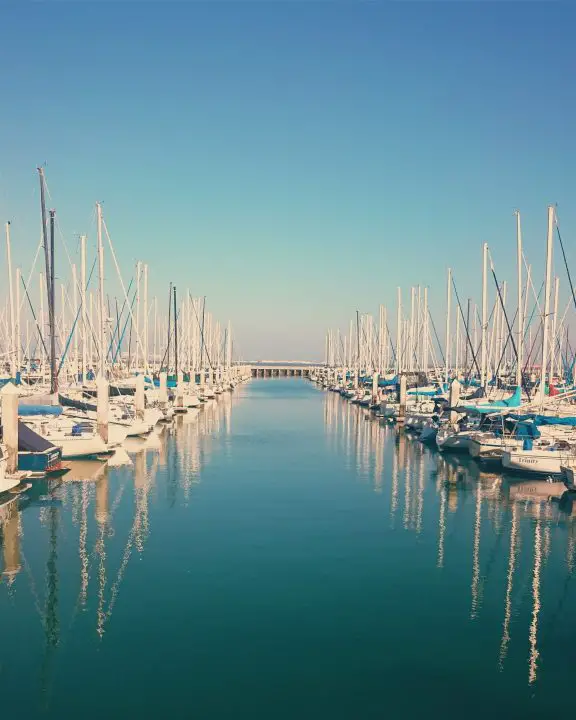
Before Boat Shopping, Consider Your Needs and Wants
Boat shopping can be an emotional roller coaster ride as you sort through the dizzying array of boat designs and sailboat sizes. Before you go falling in love with your next floating home or traveling time machine, you should sit down and map out your “needs” and “wants.”
These are the things that are deal-breakers. If a boat doesn’t have it, you’re not even going to look—despite that sweet shear line and beautiful clipper bow.
The trick with your needs list is to be brutally honest with yourself. But, again, this is challenging if it’s your first boat. It’s tough to do because once you get on a boat, you might start realizing that what seemed like “wants” get elevated to “needs” quickly.
Of course, the opposite is true, too, since the pendulum swings both ways. Things you think you need fall away and become less important sometimes.
These are those things that would be great for your new boat to have but that you can likely do without. Thinking about the features you’d like to have will help you narrow down the size of boat you need because it will enable you to shop for the boats that have those items. For example, an island berth in the stateroom might be a want, but when you discover that you need a 42 to 45-foot boat to get that, it may help you narrow your field of potential boat sizes.
After you’ve got your needs and wants lists complete, start seeing what size boats fit your bill.
You’ll quickly realize that boat size is like flavors in an ice cream shop. If one flavor suited all tastes, they’d probably only sell one. But instead, we live in a world where you can have any flavor you can imagine.
You’ll find lots of stories touting the benefits of minimalist living on a sailboat. Like their land counterparts, the tiny house owners, tiny boat dwellers pride themselves in owning as few possessions as possible and reducing clutter in their lives. Of course, boats are an excellent way to do this, but taking it to the extreme can be very uncomfortable for some people.
No matter whether you’re coming from an RV, a ranch-style house in the suburbs, or a waterfront mansion on the Intracoastal, moving onto a boat will be a downsize no matter what size boat you choose. It is all relative to your life and your budget. Boats are small living spaces, and buying a tiny one to make a point of it could be very uncomfortable. So instead, you need to find the one that is comfortable to be on.
Of course, there are many downsides to getting too large a boat. Boats cost exponentially more to keep and maintain as they get bigger. A bigger boat has a bigger engine, bigger sails, bigger rigging, and more complex systems that need more maintenance. In addition, it requires a bigger slip at a marina with deeper water access, and it might mean limiting yourself to expensive ocean ports where docks are more expensive, to begin with.
The point is, no one is going to use your boat like you’re going to use it. You’re buying a boat for a very specific purpose–so don’t let other’s influence your decision too much by telling you how they’d do it.
Your budget will be the limiting factor in your boat purchase. For most used boats sold, the overall size is relative to the overall price.
There are outliers, of course. You can eliminate project boats that lure you in by promising a bigger boat at a small boat price. These will invariably need much more money to refit and prepare than just buying a well-equipped and maintained small boat.
Similarly, premium brands might get you a smaller boat for a big boat price. Premium brands, however, do hold their value well and are generally better maintained and better built in the first place.
So buying a boat starts with settling on your needs and wants, listening to a few recommendations on the lifestyle, and finally looking at your budget. Together, these things give you a starting point, but it still is not an easy choice. It would be best if you still went see some boats.
Ways to Consider Sizes of Sailboats
- By Saliboat length and width
- By type of boat
- By sailboat group
Boats are measured by their lengths. But many different measurements are used, and makers do not standardize how they make their model numbers. Some use feet, some use meters. Some use waterline length (LWL), some length overall (LOA), and some use length on deck.
So looking at the model name of a sailboat tells you very little about a boat and how much space it has. To know the actual length, how much you’ll be paying in slip fees, or how much space you’ll have to live in, you need to dive into the numbers carefully.
Besides the specifications, don’t forget that boats are built to do different jobs. A boat designed for offshore sailing tends to have deeper and narrower hulls, smaller portlights, and less living space, while boats for coastal cruising use larger portlights, bigger cockpits, and walk-through transoms.
You can also differentiate boats of various eras by their sizes. You can’t compare the living space on a classic 1970’s offshore cruiser to what you’d find on a modern cruiser. Designs have changed, and living space has increased. These longer boats look different on the outside—and even more has changed on the inside.
Even with all these differences to look for, boats are more alike than you might realize. I’ve often noticed that when shopping for sailboats, you can start to group different models that interest you together into categories.
To some extent, these groupings are generalizations because there will always be specific makes and models that stand out. But the goal here is to demonstrate the sort of boat you could expect to get in each generally accepted group—what it would be suitable for and what living aboard would be like.
Sailboat Groups:
Monohull Cruising Sailboats
Smaller boats less than 30 feet.
Boats under 30 feet are generally suitable for day trips or weekends. As overnight accommodation, they’ll likely feel less like living on a glamorous yacht and more like camping. Most boats 25 feet and longer will have a v-berth and an enclosed head, but cooking space will be cramped, and there will be very little storage for supplies and provisions. A solo sailor with a minimalist lifestyle could live aboard a beamy 22 to 29-foot sized boat with few problems, but a couple would need to have a very healthy relationship to last very long in such a small space.
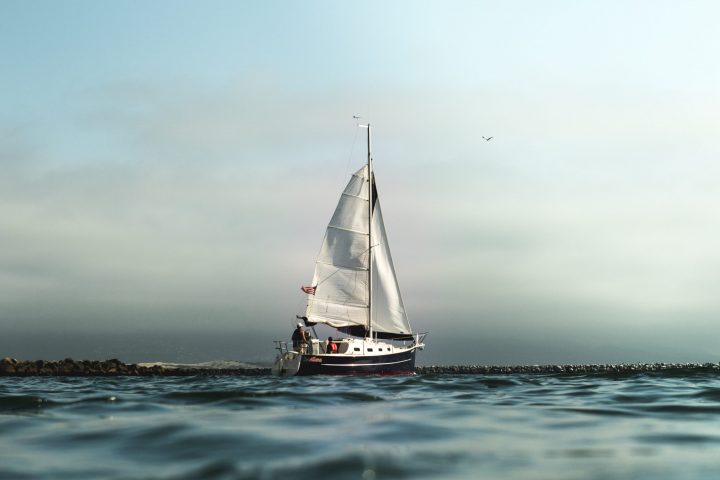
30 to 34 Feet
At 30 feet or so, a few boats begin providing impressive amounts of interior space, enough so that solo sailors or salty couples could live aboard full time. The Catalina 30 is one such example, a beamy coastal cruiser with a fantastic amount of interior space and an open floor plan that encourages you to spread out.
In offshore vessels, a couple of notable 34-foot vessels have a similar amount of size and can comfortably be outfitted for long trips. But these boats are small by the standards of most modern cruisers, and their owners will have far less room for provisions, water, fuel, and stuff than others.
35 to 40 Feet
The range between 36 and 38 feet is a crowded market for sailboats since this size range suits many different needs. There begins to be enough space to spread out, and there is often more than one stateroom with private doors. The boat is big enough to outfit and load up for long-distance cruising for a couple. For a family, there’s enough bunks and space to spend a week aboard with few quibbles. The salon has seating to entertain between four and six people comfortably.
Living on a boat this size is still small, however. The galleys are usually cramped, and there are seldom extras onboard like a separate freezer. Storage is always a challenge, especially if you’re packing for a long journey. And the boat bed is usually a wedge-shaped v-berth like a smaller boat, which will require one person to climb over the other all the time.
40 to 45 Feet
If you want more space to spread out, more privacy, and more storage than you might need, look at boats over 40 feet.
Two significant upgrades you get in boats this size include an island berth and a separate shower stall. These might seem trivial to small boat shoppers, but these are great upgrades when living aboard full time, especially for older couples. Another plus is the galleys, which have much more useable storage for provisions and counter space for food prep. The salon seating in a boat this size can usually host six to eight people very comfortably.
Boats above 40 feet tend to get more challenging to operate, however. The sail area has a greater force in a breeze and is heavier to raise, the anchoring equipment is larger and requires an electric windlass, you’ll want a diesel generator for power, and docking will likely require a bow thruster. In other words, not only are they larger and more complicated, they become a lot more expensive. Big boats have extensive systems, and the leap into a boat above 42 feet is usually a significant jump in price from 38 feet long.
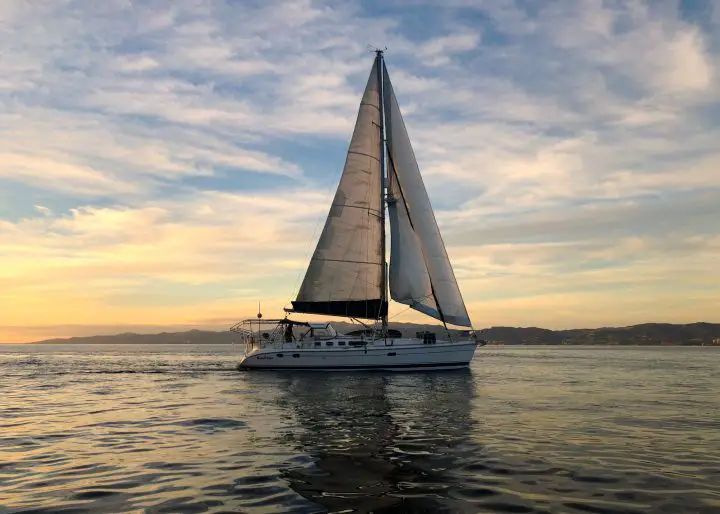
45 to 50 Feet
By the time you get to larger sailboats over 45 feet, you’ve gone up another notch. Yes, everything is more expensive, but all the luxuries of home come on board. You’ll likely have an (albeit small) washer and dryer. Offshore boats will likely have a watermaker , so you never run out of water. There will be plenty of space for dinghies or paddleboards. There will likely be three completely private staterooms and at least two heads below. The galley will have everything home does—stovetop, oven, microwave, coffee maker, blender, fridge, separate freezer, and anything else you could ask for.
Boats of this size begin to be limited by where they can travel. Their masts are tall, and they may be limited to open-ocean port cities without fixed bridges. They will also have deeper keels than their smaller counterparts, limiting their ability to travel in shallow water areas.
50 Plus Larger Boats
A large boat over 50 feet is getting into “yacht” territory. It will likely have every luxury of home, but it will also be full of complicated systems and will be expensive to maintain and store. Boats of this size are popular with couples who often travel with guests or large families who often travel together.
Small Coastal — Less than 37 Feet
A few cats come in less than 37 feet—one popular model is the Gemini 105MC . These boats are known as coastal cruisers for the most part because they don’t generally hold enough gear for long passages, although many have done them.
These small catamarans lack the same grandeur of their larger counterparts. They’ll still have large salons with big tables that can seat six or eight people, but the galley is usually down in a hull. There is usually one sizeable queen-sized berth for the owners and smaller staterooms for guests or storage. Many of these boats are powered by outboards or a single inboard motor.
Small Offshore — 37 to 40 Feet
The most popular boat model in this range is the Lagoon 380 , of which Lagoon built almost 1,000 hulls. There are smaller catamarans available, but this one stands out for its excellent living space and classic “catamaran” layout. Other popular models in this range include the Leopard 38, 39, and 40 (all generations).
These cats are entry-level for ocean crossing capable cats, and they’re perfectly sized for cruising couples. They’re easy to handle, easy to sail, and easy to fill with stuff. They’ll usually have two queen-sized berths and one or two smaller berths, all in entirely private cabins. There are usually two heads in each hull, and some designs feature separate showers. They’ll sleep three couples comfortably in private staterooms and can store enough provisions for a week of island hopping. For a cruising couple, they can usually store everything they’d need for a long-term voyaging within reason.
Catamarans in this size have limits, though. They tend to be easily weighed down by too much stuff, and their length causes them to “hobby horse” in choppy seas. Two inboard diesel motors power them, which are more expensive to replace or maintain than outboards.
Midrange Offshore — 41 to 45 Feet
Midrange catamarans above 42 feet tend to perform much better than the shorter boats, without the hobby horsing tendency. They have more room for gear, and they sail faster. This size boat works for couples who often have guests or traveling families.
These midrange catamarans might look a lot like their smaller sisters, but it is a significant price jump to get into boats of this size. The engines are bigger, the rigging is more stout, and the sails cover more sky.
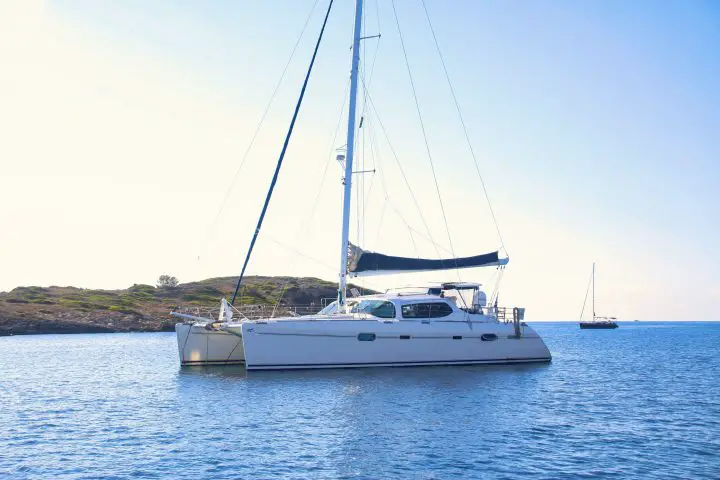
Large Offshore — 46 to 50 Feet
These bigger catamarans come from the charter companies and are designed for a crew of two to entertain three or four couples for a week at a time. There’s enough room for all six or eight people to spread out while living with two strangers, all while having privacy and space. The cockpits and salons of a boat this size can host gatherings of 20 or 30 people over for drinks. Anytime one of these cats pulls into the anchor, it’s usually a safe bet where the sundowner get-togethers will always be held.
50 Plus and Larger Vessels
The space that you find on a 50-foot cat is probably equivalent to an 80 or 90-foot monohull. The salon is enormous, and there is usually a flybridge with an entirely separate seating and entertaining area.
Catamarans this size are large vessels. Their twin engines make maneuvering easy, but like handling larger monohulls, anyone handling this size boat will need to get trained by an experienced captain with great sailing skills before setting out.
If you haven’t spent much time on boats, nailing the size of the boat you want requires more than just imagination and web articles (as good as those may be)! There is simply no substitute for getting on a boat, for standing inside its cabin, sitting on its settees, and manning its helm. There is no other way to find out what the space is like—is it cozy and warm or cramped and terrifying?
Like buying a home in a strange neighborhood, if you’re struggling with finding the right size boat, consider enlisting the help of a buyer’s agent or buyer’s broker. Yacht brokers work exactly like real estate agents, and it is common to enlist one to help you purchase a boat. In addition, knowledgeable brokers familiar with the type of sailing you want to do can guide you through the search process and get you access to view and step onboard many different types and sizes of sailboat.
What are the sizes of sailboats?
Sailboats come in every shape and size, from single-person Opti sailing dinghies to the largest in the world, the Sailing Yacht A, at 142.8 meters (468.5 feet). Sailboats are generally measured by either their length overall (LOA) or length on deck (LOD). Most private sailboats fall somewhere between 25 and 40 feet long.
What size sailboat should I buy?
Everyone is looking for something different when they buy a sailboat. Your choice of boat greatly depends on how you want to sail it, where you want to take it, and how much time you’re planning to spend aboard. The best way to get a feel for what size will work for you is to get as much sailing experience as you can before you purchase. Take sailing lessons, stay overnight on boats, and consider a bareboat charter vacation.
What is a good size sailboat for the ocean?
Finding a good bluewater cruiser to cross oceans is about choosing a reliable and trustworthy design built to a high standard by a reputable boatyard. This is much less about size than many people believe. There are very stout and small boats that have circumnavigated the globe, including the tiny 22-foot Falmouth Cutter or the Flicka 20.
Most people looking to go voyaging will find that minimalism required to make a small boat like those work to be limiting. While it was once quite common for world cruisers to set out on boats under 35 feet, most people today set off in vessels 40 feet or longer.
Matt has been boating around Florida for over 25 years in everything from small powerboats to large cruising catamarans. He currently lives aboard a 38-foot Cabo Rico sailboat with his wife Lucy and adventure dog Chelsea. Together, they cruise between winters in The Bahamas and summers in the Chesapeake Bay.
- BOAT OF THE YEAR
- Newsletters
- Sailboat Reviews
- Boating Safety
- Sailing Totem
- Charter Resources
- Destinations
- Galley Recipes
- Living Aboard
- Sails and Rigging
- Maintenance
2022 Boat of the Year: Best Midsize Cruiser (Under 40’)
- By Cruising World Editors
- December 15, 2021
During and in the four days immediately following the US Sailboat show in Annapolis, Maryland, the Cruising World judges inspected and sailed on 27 boats vying for recognition. Learn more about the boats in our 2022 Boat of the Year »
Once upon a time, midsize cruisers, 30 to 40 feet, dominated the market, and harbors across the US were filled with what were once considered to be “big” family sailboats. In this size range, a boat could sleep six or seven crew, with some models even offering one or more private staterooms. These boats often offered amenities such as hot and cold pressurized water, a shower and refrigeration, and they were capable coastal cruisers, while some went on extended voyages, including circumnavigations.
Sadly, the proliferation of midsize sailboats—and dozens of American builders launching them—is no longer the case. In fact, in this post-pandemic era, the midsize cruiser is an endangered species; the major overseas production boatyards have largely abandoned the entry-level buyer in lieu of manufacturing bigger boats that address the demand for three, four and even five private cabins, often with en suite heads. But all is not lost for sailors looking for new boats under 40 feet because there are still several companies knocking out quality vessels in well-designed packages that will get you just about anywhere you wish to go. Here’s a trio of craft that fits that bill and, collectively, they made a splash at the U.S. Sailboat Show in Annapolis, Maryland this year.
The “C” in German builder Bavaria’s C38 is for “cruising,” and more specifically, as stated by company reps, family coastal cruising. It’s a sweet spot for the under-40-foot market, and Bavaria has managed to pack a lot of punch in that length overall. Hard chines maximize the interior volume, and the three staterooms in this roomy two-head 38-footer are expansive and impressive. BOTY judge and yacht designer Gerry Douglas noted the wide radius of the bow, which allowed the owner’s cabin below to be pushed far forward, making the most of the interior space.
Twin wheels have become the rule, not the exception, in contemporary cruisers, and the Bavaria’s are stationed well outboard, which provides plenty of visibility forward and a nice passage from the cockpit to the drop-down transom and boarding ladder. Sail control lines are led aft to winches at either wheel. The boat our judges sailed had an easy-to-manage self-tacking jib and an in-mast furling main; an over-lapping genoa is available for owners looking for a little more oomph from the rig.
The C38 was designed by Cossutti Yacht Design, a firm known for slippery hulls. Underway, its single rudder felt responsive, and on a close reach, the boat scooted along nicely.
Overall, judge Ed Sherman thought its stated purpose—”a family coastal cruiser”—was an honest and straightforward one.
The Sun Odyssey 380 is the fourth boat in Jeanneau’s line of cruising sailboats to employ the walk-around deck that has earned a host of awards and recognition in Boat of the Year circles. Rather than having to climb over the coaming to reach the deck, the side deck slopes down as it passes the cockpit, so crew can simply walk around either of the two helms and stroll forward. An added bonus is the height of the rear pulpit railings and lifelines as one makes the transition.
This latest design from performance-oriented French naval architect Marc Lombard combines a host of go-fast features: twin wheels and dual rudders; an integrated bowsprit for setting quick-reaching and running sails; a high-aspect rig that will acquit itself well not only for speedy passages, but also for those inclined to mix it up on the club racecourse.
The boat we sailed had a traditional main and boom sail pouch, which was a refreshing change from the in-mast furling sails many of the other boats in the fleet carried. Rather than fairleads mounted on genoa tracks, the over-lapping jib’s sheets are run through friction rings that can be adjusted up and down, as well as in and out, an arrangement that allows for true fine-tuning of the sail’s shape. The result, well, let judge Tim Murphy weigh in here: “It really was a lovely boat to sail. Boy, and we got out there this morning, the breeze was light and you really, really felt the pleasure of going sailing.”
The 380 was comfortable, as well. Down below, the layout is traditional, with a simple saloon incorporating the galley, dining area and nav station. What’s not broken need not be fixed.
Rounding out this category was a very different boat, the Hallberg-Rassy 340 , built in Sweden at a yard renowned for its bluewater cruisers.
At 80, the great Argentinian naval architect Germán Frers is a living legend, with an unparalleled career designing everything from high-end race boats to superyachts. But Frers is nothing if not versatile, which he proved with this beautiful, twin-wheeled cruiser. Judge Ed Sherman summarized its winning appeal: “We started our sea trial with no wind, then it built slowly. And this boat sailed beautifully. It’s such high quality; it’s high-end, furniture-grade interior versus the Ikea treatment we sometimes see. What an impressive boat.”
The other judges were not far behind in their praise of this twin rudder, twin wheel boat—quite a change of pace for the builder, though it allows for beam to be carried farther aft, creating additional volume for accommodations below.
In describing the design brief, judge Tim Murphy recalled that the importer of the boat described it as being intended for a cruising couple to go out for a weekend, a week or a month. In practical terms, this translates into adequate storage, a workable galley and accommodations that allow a crew to feel secure and stay rested, both underway and at anchor.
Said Murphy, “I love the interior of that Hallberg-Rassy maybe more than any boat in this year’s fleet. I loved being in that space.” And his colleagues did too, which is how the 340 came to be named Best Midsize Cruiser (Under 40’).
- More: bavaria yachts , Boat of the Year , Boat of the Year 2022 , hallberg-rassy , Jeanneau Yachts , Sailboats
- More Sailboats
A Gem in New England
Thinking of a shift to power, tradewinds debuts 59-foot twe6 smart electric yacht, sailboat preview: dufour 44, good bread for good health, center of effort, the halfway point: sailing to bermuda.
- Digital Edition
- Customer Service
- Privacy Policy
- Email Newsletters
- Cruising World
- Sailing World
- Salt Water Sportsman
- Sport Fishing
- Wakeboarding

Choosing the Right Size Sailboat to Safely Cross the Pacific
Alex Morgan
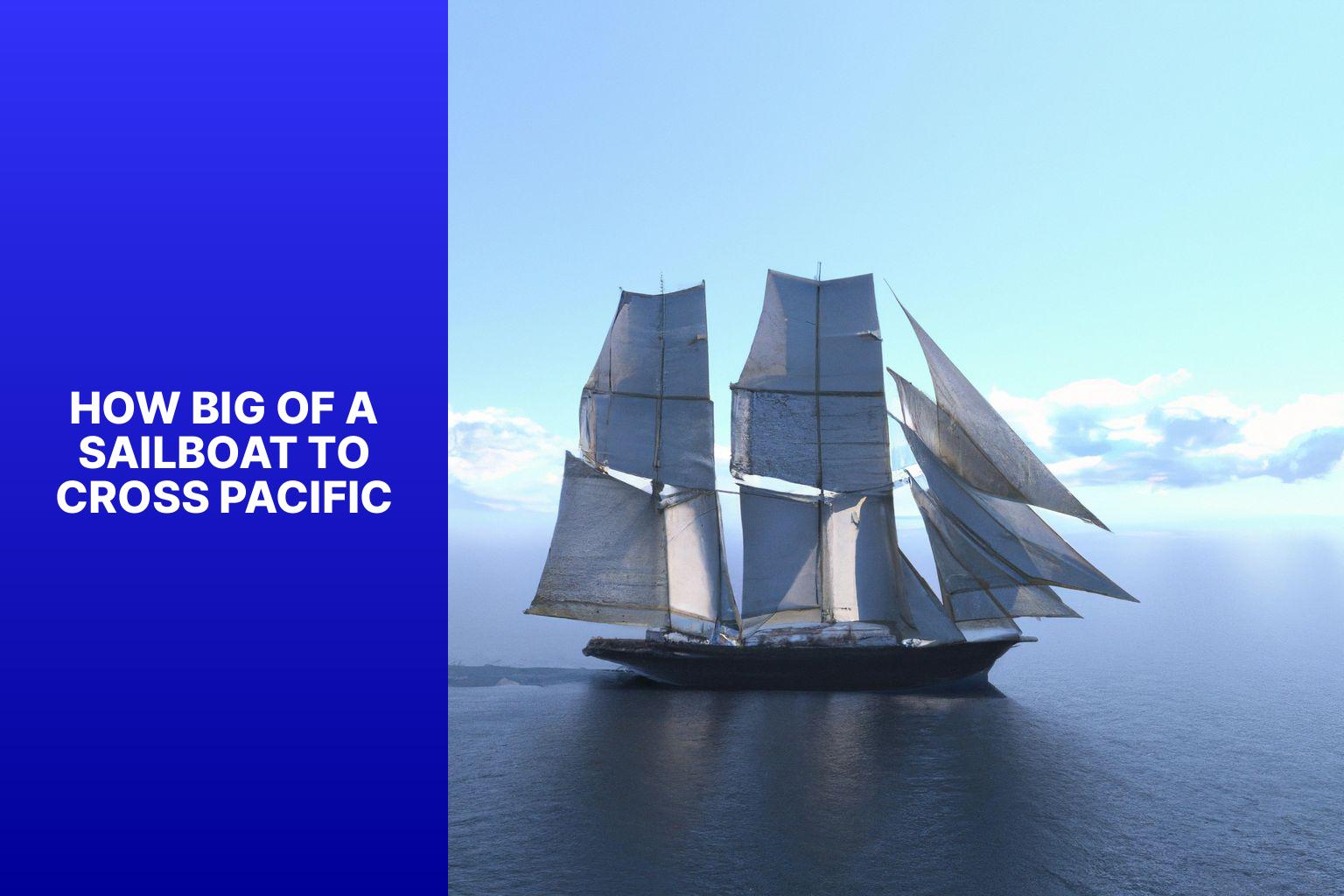
Crossing the Pacific by sailboat is a dream for many sailing enthusiasts, offering an incredible adventure and the opportunity to explore some of the world’s most stunning destinations. Determining the right size sailboat for such a voyage is a crucial consideration. Various factors come into play when choosing the right sailboat size, including safety, seaworthiness, crew size and experience. In this guide, we will explore the factors to consider beyond size, the minimum size requirements for crossing the Pacific, sailboat design considerations, and recommended sailboat types for this expedition.
When considering the right size sailboat, safety and stability are of utmost importance. The sailboat should be sturdy enough to withstand the challenges of the open ocean and handle adverse weather conditions. Seaworthiness is another critical factor, as the sailboat should be able to navigate through rough seas and heavy swells with ease. The size of the crew and their level of experience should be taken into account, as it affects the handling and maintenance of the sailboat during the voyage.
Meeting the minimum size requirements is essential for a successful Pacific crossing. The recommended length, minimum displacement, and sufficient sail area are key considerations for ensuring the sailboat’s performance and capability to handle long passages. These requirements are influenced by the size and weight of the sailboat, contributing to its stability, speed, and maneuverability.
Beyond size, other factors should be considered when selecting a sailboat for this journey. The sailboat should be equipped with the necessary equipment and systems to ensure safety and functionality throughout the voyage. Autonomy and self-sufficiency are crucial for long passages, as the sailboat should be able to sustain the crew with sufficient resources and energy. Comfort and amenities are also important for ensuring a comfortable and enjoyable experience during the crossing.
Sailboat design considerations play a significant role in the performance and suitability for a Pacific crossing. The hull design should provide stability and seaworthiness, while the rigging and sail plan should be optimized for various weather conditions. The keel and ballast also contribute to stability and the ability to maintain a steady course.
While there is no one-size-fits-all sailboat for crossing the Pacific, there are recommended sailboat types that have proven to be reliable and suitable for long passages. Bluewater cruisers, catamarans, and offshore racer-cruisers are popular choices among sailors embarking on this journey, each offering their own advantages and considerations.
To ensure a successful Pacific crossing, proper planning and preparation are essential. Beyond selecting the right sailboat size, considering factors such as weather patterns, navigation, communication, and safety equipment is crucial. By taking these guidelines into account and making informed decisions, you can embark on the adventure of a lifetime across the Pacific Ocean.
Key takeaway:
- Choosing the right size sailboat for crossing the Pacific is crucial for safety and stability.
- Considerations such as seaworthiness, crew size, and experience should be taken into account when selecting a sailboat.
- Minimum size requirements for crossing the Pacific include recommended length, minimum displacement, and sail area.
- Equipment and systems, autonomy and self-sufficiency, and comfort and amenities are important factors to consider.
- Sailboat design considerations such as hull design, rigging and sail plan, and keel and ballast are key for a successful Pacific crossing.
- Recommended sailboat types for crossing the Pacific include bluewater cruisers, catamarans, and offshore racer-cruisers.
- Additional tips for planning a Pacific crossing should be taken into consideration for a successful journey.
Considerations for Choosing the Right Size Sailboat
When it comes to crossing the Pacific by sailboat, choosing the right size vessel is crucial. In this section, we’ll explore key considerations that will help you make an informed decision. We’ll delve into factors like safety and stability , seaworthiness , and crew size and experience . By understanding the importance of these aspects, you’ll be well-equipped to select the perfect sailboat for your Pacific adventure. So, let’s dive in and set sail towards an unforgettable journey across the vast ocean!
1. Safety and Stability
When crossing the Pacific in a sailboat, safety and stability are of utmost importance. To ensure a safe journey, it is essential to consider the following factors:
– Hull strength: The sailboat’s hull should be robust and able to withstand rough ocean conditions and potential impacts, ensuring the safety and stability of the vessel.
– Ballast: Sufficient ballast is key to improving stability, particularly in heavy seas and high winds, promoting a secure and well-balanced sailboat.
– Keel design: Opting for a deep or fin keel offers additional stability, while a shoal draft or lifting keel allows for access to shallower waters. These design choices contribute to the overall safety and stability of the sailboat.
– Heel angle: A lower heel angle inherently provides a smoother and safer sailing experience, prioritizing the safety and stability of the journey.
– Stability ratios: By considering stability ratios such as the capsize screening ratio and angle of vanishing stability, you can assess the sailboat’s ability to handle extreme weather conditions, ensuring the utmost safety and stability for your voyage.
– Seaworthiness: It is crucial to select a sailboat with a proven track record of successful ocean voyages and features that enhance seaworthiness, such as a fully enclosed cockpit or reinforced rigging. These features further contribute to the safety and stability of your Pacific crossing.
– Steering control: A reliable and responsive steering system is of utmost importance in maintaining control, especially in challenging conditions, enhancing the overall safety and stability of your sailboat.
– Emergency equipment: Ensure that the sailboat is equipped with essential safety gear, including life jackets, offshore life rafts, and emergency communication devices. These items are crucial for safety and stability during unexpected situations.
– Crew training and experience: The competency and experience of the crew significantly impact the safety and stability of the Pacific crossing. Having a well-trained crew enhances the overall safety and stability of the sailboat.
– Maintenance: Regular maintenance and inspection of all sailboat components and systems are essential. This preventive measure helps prevent failures that could compromise safety and stability , ensuring a secure journey.
By considering these factors, you can choose a sailboat that prioritizes safety and stability , providing peace of mind throughout your Pacific crossing.
2. Seaworthiness
When considering the seaworthiness of a sailboat for crossing the Pacific, keep these factors in mind:
- Hull strength and design : The hull should be sturdy and able to withstand rough ocean conditions. Look for reinforced hulls and a stable design.
- Stability in different weather conditions: The sailboat should have a stable design to handle various weather conditions, including rough seas and strong winds. Look for features such as a deep keel and a balanced sail plan.
- Reserve buoyancy and self-draining cockpit : The sailboat should have reserve buoyancy to stay afloat during heavy waves or a capsize. A self-draining cockpit is important to prevent water accumulation and maintain boat stability.
- Quality of rigging and sail handling : The rigging should be strong and able to handle wind forces. Look for high-quality materials and proper maintenance. Easy and efficient sail handling systems are important for maneuverability.
- Emergency and safety equipment : The sailboat should be equipped with necessary safety equipment, including life jackets, offshore life rafts, and communication devices. Prioritize safety and be prepared for emergencies.
Considering these factors will help ensure that the chosen sailboat has the necessary seaworthiness for a successful Pacific crossing.
3. Crew Size and Experience
- When deciding crew size for a Pacific crossing, it is important to assess each crew member’s experience and capabilities.
- For long journeys, having a larger crew can bring a wider range of skills and knowledge, which is beneficial.
- It is important to consider that a larger crew can also create conflicts and challenges in managing space and resources on the sailboat.
- As a general guideline, it is recommended to have a crew of at least three people for a Pacific crossing.
- This allows for a watch rotation system, where crew members can take turns in shifts for sailing , navigation , and maintenance tasks.
- It is crucial that each crew member has sailing experience and is able to handle navigation , maneuvering , and emergency protocols.
- In addition, crew members should also be physically fit , as long journeys can be demanding.
- To ensure a safe and successful Pacific crossing, the crew size should be determined based on the experience, skills, and capabilities of everyone on board.
Minimum Size Requirements for Crossing the Pacific
When it comes to crossing the vast Pacific Ocean, the size of your sailboat matters. Let’s dive into the minimum size requirements for this epic journey.
From recommended length and minimum displacement to sail area, we’ll uncover key factors that ensure a seaworthy vessel. But it’s not just about the boat; we’ll also explore the essential equipment and systems, autonomy and self-sufficiency, as well as the comfort and amenities needed to conquer this adventure. Get ready to set sail on the Pacific!
Recommended Length
A sailboat to cross the Pacific is typically around 40-50 feet . This size provides space and stability for long-distance ocean voyages. A larger sailboat allows for comfortable accommodations and storage for supplies, reducing the need for frequent resupply stops.
A sailboat of this length offers maneuverability and seaworthiness. It can handle different weather conditions and provide stability in rough seas, reducing the risk of capsizing or being affected by strong winds.
When choosing the recommended length, factors such as the number of people on board, the amount of equipment and supplies needed, and the desired level of comfort should be considered. A larger sailboat can accommodate a larger crew and provide more amenities, making the journey more enjoyable.
Smaller sailboats have also successfully crossed the Pacific, but they may require additional planning and consideration to ensure safety and comfort during the voyage.
Minimum Displacement
The minimum displacement of a sailboat is crucial for Pacific crossings. It specifically refers to the weight of the boat and how much water it displaces. Opting for a sailboat with a minimum displacement of 10,000 kilograms or 22,046 pounds is highly recommended when planning a Pacific crossing. This ensures that the boat can effectively handle the challenging conditions that arise during long ocean passages. A higher displacement provides more stability in rough sea conditions, which is essential for a safe journey.
In addition to displacement, other factors such as hull design, rigging, and sail plan also contribute to a sailboat’s seaworthiness. It is important to carefully consider these factors when selecting a sailboat for a Pacific crossing. By taking into account all these aspects and choosing a sailboat with an appropriate minimum displacement, sailors can ensure a safer and more comfortable journey across the Pacific Ocean. Ultimately, safety should always be the top priority when embarking on a long-distance sailing adventure.
Sail area is a crucial factor when choosing a sailboat for crossing the Pacific. It is the total area of the sails on the boat that directly impacts the boat’s performance and ability to harness wind power. The size of the sail area determines the boat’s power and speed. It is essential to strike a balance between sail area and boat size to ensure safety and stability.
For smaller sailboats (10-15 feet), it is recommended to have a sail area of 50-100 square feet , which is approximately 6-7% of the boat’s displacement. As the boat size increases, the sail area can also increase proportionally. For instance, a 36-40 feet sailboat should have a sail area of 700-1000 square feet , which would be around 1-2% of its displacement.
It is important to note that these recommendations are general guidelines and may vary depending on specific boat designs and conditions. Seeking advice from experienced sailors or boat designers can provide more accurate recommendations tailored to individual factors.
When considering sail area, it is important to prioritize safety, stability, and the overall seaworthiness of the sailboat. Striving for the right balance between sail area and boat size will ensure a comfortable and efficient voyage across the Pacific.
1. Equipment and Systems
When deciding on equipment and systems for a sailboat, it is important to prioritize safety , functionality , and efficiency .
For safety features, it is necessary to make sure that the sailboat is equipped with essential equipment such as life jackets , flares , a first aid kit , and a fire extinguisher .
Investing in reliable communication systems such as a VHF radio , GPS , and an EPIRB (Emergency Position Indicating Radio Beacon) is crucial for emergencies and staying connected.
In terms of navigation equipment, equipping the sailboat with tools like a chart plotter , compass , and depth sounder or sonar is essential for accurate navigation and avoiding hazards.
The boat should have a well-functioning electrical system, including batteries , charging systems like solar panels or wind generators , and proper wiring to power essential equipment.
To ensure access to clean water for drinking, cooking, and hygiene, it is important to install a reliable freshwater system with a water tank , pump , and plumbing .
A functional galley and cooking equipment such as a stove , oven , refrigerator , and storage space for food and utensils are necessary for cooking and food storage on the sailboat.
Considering renewable energy sources like solar panels or wind generators for power during long journeys and ensuring sufficient storage capacity is crucial for power generation and storage.
Including emergency equipment like a life raft , anchor , and emergency tiller is important to prepare for unforeseen circumstances or equipment failures.
2. Autonomy and Self-sufficiency
To ensure autonomy and self-sufficiency on a Pacific sailboat crossing, it is important to consider the following factors. Energy generation can be achieved by installing solar panels or wind turbines for electricity. Ensuring a sufficient water supply can be done by having a water desalination system or proper water storage. It is crucial to stock up on non-perishable food items and have proper storage for food. Reliable navigation instruments and backup systems should be in place to ensure smooth navigation. Having communication equipment such as satellite phones or radios is essential for emergency communication.
In addition to these factors, it is advisable to have contingency systems and backup supplies for emergencies. Regular maintenance and inspection of all onboard systems are necessary to ensure proper functioning and reliability. By being self-sufficient and prepared, safety and success during the Pacific crossing can be greatly enhanced.
Throughout history, adventurous sailors have crossed the Pacific with limited resources, relying on their skills to navigate and survive. Autonomy and self-sufficiency have always been essential, as they allow for the exploration of new lands and cultures. Nowadays, with advanced technology and improved sailing equipment, achieving even greater levels of autonomy and self-sufficiency is possible, ensuring a smoother and more enjoyable adventure across the vast Pacific Ocean.
3. Comfort and Amenities
Comfort and amenities are paramount when embarking on a pleasant journey across the Pacific by sailboat. Below are some key factors to take into account:
1. Sleeping accommodations: It is essential to search for sailboats that offer spacious and comfortable sleeping areas. Consider the layout of the cabins and the number of berths available.
2. Galley facilities: To live comfortably during the journey, make sure the sailboat has a well-equipped galley. This should include a stove, oven, refrigerator, and ample storage space for food and cooking supplies.
3. Bathroom facilities: Sailboats that have enough bathrooms with showers and toilets provide convenience and ensure the comfort of the crew.
4. Seating areas: Look for sailboats that provide both indoor and outdoor seating areas that are comfortable and conducive to relaxation and socializing.
5. Entertainment options: Consider sailboats that offer various entertainment options such as a TV, DVD player, music system, or even internet connectivity.
6. Climate control: It is crucial to have effective heating and cooling systems on board to ensure comfort in different weather conditions.
7. Storage space: Adequate storage space for personal belongings, equipment, and supplies is vital to maintain a clutter-free living environment.
8. Lighting and ventilation: Look for sailboats that have plenty of natural lighting and well-designed ventilation systems, which create a pleasant and airy living space.
Taking these comfort and amenities factors into consideration will help you select a sailboat that will provide an enjoyable and comfortable experience throughout your Pacific crossing.
Sailboat Design Considerations for Pacific Crossing
When it comes to crossing the vast Pacific Ocean, sailboat design plays a vital role in ensuring a safe and successful journey. In this section, we’ll dive into the key considerations for sailboat design when undertaking a Pacific crossing. From the hull design to the rigging and sail plan, and even the keel and ballast , each aspect holds its significance in navigating the challenging waters. So buckle up and let’s explore the essential factors that shape the design of sailboats for this epic voyage!
1. Hull Design
When considering the hull design for a sailboat, there are a variety of options to choose from. One option is a monohull , which features a single hull and a keel to provide stability. Another option is the multihull design, which includes two or more hulls, like catamarans or trimarans , to increase stability and speed.
If navigating rough seas is a concern, the full keel design is a great choice, as it offers excellent stability and tracking. For those looking for better maneuverability and speed, the fin keel design, with its shorter and more aerodynamic keel, is recommended. The bilge keel design is worth considering, as it provides good stability and the ability for the sailboat to sit upright on the ground.
Each hull design has its own advantages and considerations, and the choice ultimately depends on the specific needs and preferences of the sailor. Whether it’s the speed and stability of a multihull or the timeless appeal of a monohull, the hull design greatly influences the performance and safety of the sailboat during a Pacific crossing.
2. Rigging and Sail Plan
When considering the rigging and sail plan for a sailboat crossing the Pacific, several factors are important.
1. Sail setup: The rigging and sail plan need to handle different wind conditions during the crossing. This includes having different sail sizes and types, like the mainsail , jib , and spinnaker , for optimal performance in various wind directions and strengths.
2. Durability and reliability: The rigging should be strong and well-maintained for long-distance ocean sailing. This includes a sturdy mast and boom , reinforced fittings, and high-quality sail materials that can handle constant exposure to sun, wind, and saltwater.
3. Maneuverability and ease of handling: The sail plan should allow for easy reefing and adjusting of sails to adapt to changing weather conditions. This includes a well-designed and efficient reefing system, reliable winches and lines, and proper sail controls like traveler and adjustable backstay .
4. Safety features: A reliable and well-maintained rig is important for crew safety. This includes regularly inspecting the standing rigging, such as shrouds and stays , for wear or damage. It is also beneficial to have backup sails and spare rigging components on board.
5. Performance considerations: The rigging and sail plan should be optimized for speed and efficiency. This includes a balanced sail area, proper mast rake, and adjustable rig tension to maximize the boat’s performance and minimize strain on the sails and rigging.
By considering these factors, sailors can ensure they have a well-equipped and properly designed rigging and sail plan that enhances the safety, maneuverability, and performance of their sailboat during a Pacific crossing.
3. Keel and Ballast
The keel and ballast play a crucial role in ensuring stability and performance during a Pacific crossing for a sailboat. Attached to the bottom of the boat, the keel acts as a weighted structure that prevents capsizing and provides stability. Additional weight, known as ballast, is added to the keel to enhance stability and increase the boat’s righting moment .
Offshore sailors generally prefer a deeper keel with more ballast as it offers better stability in rough seas. To optimize performance, it is important to carefully distribute the ballast along the length of the keel, ensuring proper weight distribution and minimizing drag. When considering the size, shape, material, and placement of the keel and ballast, it is advisable to consult experts or experienced sailors. They can provide guidance in determining the appropriate keel and ballast configuration for a successful Pacific crossing.
Recommended Sailboat Types for Crossing the Pacific
When it comes to embarking on a Pacific crossing, the right sailboat can make all the difference. In this section, we’ll dive into the realm of recommended sailboat types for this epic journey. From sturdy bluewater cruisers to sleek catamarans and versatile offshore racer-cruisers , we’ll explore each sub-section’s unique characteristics and benefits. So, grab your compass, hoist the mainsail, and let’s set sail on a thrilling exploration of the sailboat types that are tailor-made for crossing the vast Pacific Ocean.
1. Bluewater Cruisers
When considering sailboats for a Pacific crossing, bluewater cruisers are an excellent choice . Bluewater cruisers have sturdy construction to endure harsh ocean conditions and heavy winds. These sailboats have excellent stability and can handle rough seas and challenging weather conditions. Bluewater cruisers have comfortable and spacious interiors , with multiple cabins and ample storage space for long passages. These sailboats have large fuel and water tank capacities , allowing for longer passages without frequent refueling or resupply. Bluewater cruisers have robust systems for water-making, power generation, and storage, reducing dependence on external resources during long journeys. These sailboats have secure and well-designed cockpits , providing a safe and stable area for crew members during rough weather or heavy seas. Bluewater cruisers have a history of successful ocean crossings , making them a trusted choice for sailors on a Pacific crossing. These sailboats offer comfortable amenities, such as larger berths, well-equipped galley spaces, and spacious saloons, ensuring a more enjoyable experience during extended passages.
2. Catamarans
Catamarans offer several advantages and disadvantages to consider when crossing the Pacific:
Advantages:
1. Catamarans provide more interior space and living areas compared to monohulls.
2. They are known for their stability, which is beneficial for long-distance ocean crossings.
3. Catamarans have shallow drafts, allowing them to access shallow anchorages and coves.
4. They have two hulls, providing redundancy in case of hull damage.
5. Catamarans offer a smoother and more comfortable ride due to reduced rolling motion.
Disadvantages:
1. Catamarans are generally more expensive than monohulls.
2. Catamarans have a wider turning radius compared to monohulls.
3. Catamarans may have limited berthing options in some marinas.
4. Catamarans may have limited heeling ability, which affects performance under sail.
5. Catamarans require wider docking and mooring spaces compared to monohulls.
Despite these disadvantages, catamarans remain a popular choice for long-distance ocean crossings due to their comfort, spaciousness, and stability.
3. Offshore Racer-Cruisers
Offshore racer-cruisers are sailboats that excel in both speed and agility , making them perfect for navigating through rough seas and various conditions. These sailboats are built using lightweight materials such as carbon fiber , which greatly enhance their performance and velocity. They are equipped with high-performance sails, advanced rigging systems, and responsive steering, all of which contribute to optimizing sail trim and ensuring excellent control.
When contemplating an offshore racer-cruiser for your Pacific crossing , it is crucial to prioritize speed and performance . It is essential to possess the necessary experience and skills to handle the boat’s highly responsive and agile nature. It is vital to account for the trade-off between speed and comfort , as offshore racer-cruisers may have fewer amenities compared to other sailboat types. Safeguarding one’s safety should always take precedence, so consulting with knowledgeable sailors or experts is advisable when making your decision.
Additional Tips for Planning a Pacific Crossing
Tips for Planning a Pacific Crossing
- Prepare a detailed itinerary and plan for your Pacific crossing. Consider weather patterns, currents, and possible ports of call. This ensures a safe and smooth journey.
- Stock up on essential supplies and provisions before setting sail. Calculate the amount of food, water, and fuel needed for the crossing, taking into account any potential delays.
- Ensure your sailboat has necessary safety equipment: life jackets , flares, emergency rafts, and communication devices. Regularly check all systems and equipment to minimize mechanical failure.
- Familiarize yourself with international maritime regulations and requirements. Have all necessary documentation, including passports , visas , and vessel registration papers.
- Communicate and register your planned route with relevant authorities, such as coast guards or maritime agencies. This helps them track your progress and provide assistance if needed.
- Stay updated with weather forecasts and monitor conditions. Be prepared to alter course or make unplanned stops if necessary to avoid severe weather or dangerous situations.
- Maintain regular communication with friends, family, or fellow sailors to inform them of your progress and location.
- Take breaks and rest when needed to contribute to well-being and alertness at sea.
- Follow environmentally friendly practices, such as minimizing waste and pollution. Avoid disposing of garbage or waste into the ocean.
Some Facts About How Big Of A Sailboat To Cross Pacific:
- ✅ To cross the Pacific Ocean, it is recommended to have a sailboat that is at least 35 to 45 feet long. (Source: Seattle Yachts)
- ✅ Small boats, such as the Piver 25 trimaran, the Nugget, and the Contessa 26 and 32, can also successfully sail offshore if they are well-designed and well-built. (Source: Seattle Yachts)
- ✅ Boat size is less important than the quality of design, construction, and outfitting when it comes to sailing offshore. (Source: Seattle Yachts)
- ✅ It is recommended to buy a newer boat, even if it is smaller, as it will have fewer issues and be more reliable for ocean crossings. (Source: Seattle Yachts)
- ✅ Larger boats, while providing advantages in terms of speed and comfort, are more suitable for younger and more experienced sailors, whereas smaller boats are easier to handle for older sailors. (Source: Seattle Yachts)
Frequently Asked Questions
How big of a sailboat do i need to cross the pacific.
According to experts, it is recommended to have a sailboat that is at least 30 or 40 feet long to safely cross the Pacific Ocean. Smaller boats are more prone to sinking and may be unsafe in bad weather conditions.
What are the advantages of a larger sailboat for Pacific crossings?
A larger sailboat is necessary for seaworthiness, storage of supplies, and overall comfort during the journey. It provides more space for necessary equipment and ensures a safer and more enjoyable experience.
How long does it take to cross the Pacific by sailboat?
The duration of the journey can vary depending on the route and conditions, but typically it takes anywhere from five to ten weeks to cross the Pacific Ocean. It is important to consider the potential length of the trip when planning and preparing for the voyage.
What is the best time to cross the Pacific in a sailboat?
The best time to cross the Pacific is during cyclone season, which varies depending on the departure location. It is important to research and consider cyclone patterns and plan the journey accordingly to ensure safety.
Do small sailboats have limitations for ocean crossings?
While it is possible for small, well-designed, and well-built sailboats to go sailing offshore, larger sailboats are generally recommended for ocean crossings. Smaller boats may be more challenging to handle in rough conditions and may require additional motors for when the wind is not cooperating.
What are some popular choices for sailboats for Pacific crossings?
For ocean crossings and long-distance cruising, boats between 35 and 45 feet are common and work well for couples. Popular choices include production boats from brands like Lagoon, Fountaine Pajot, Beneteau, and Jeanneau. Custom-built boats from brands like Oyster, Hallberg-Rassy, Najad, and Amel are better equipped for long-distance sailing.
About the author
Leave a Reply Cancel reply
Your email address will not be published. Required fields are marked *
Save my name, email, and website in this browser for the next time I comment.
Latest posts

The history of sailing – from ancient times to modern adventures
History of Sailing Sailing is a time-honored tradition that has evolved over millennia, from its humble beginnings as a means of transportation to a beloved modern-day recreational activity. The history of sailing is a fascinating journey that spans cultures and centuries, rich in innovation and adventure. In this article, we’ll explore the remarkable evolution of…

Sailing Solo: Adventures and Challenges of Single-Handed Sailing
Solo Sailing Sailing has always been a pursuit of freedom, adventure, and self-discovery. While sailing with a crew is a fantastic experience, there’s a unique allure to sailing solo – just you, the wind, and the open sea. Single-handed sailing, as it’s often called, is a journey of self-reliance, resilience, and the ultimate test of…

Sustainable Sailing: Eco-Friendly Practices on the boat
Eco Friendly Sailing Sailing is an exhilarating and timeless way to explore the beauty of the open water, but it’s important to remember that our oceans and environment need our protection. Sustainable sailing, which involves eco-friendly practices and mindful decision-making, allows sailors to enjoy their adventures while minimizing their impact on the environment. In this…

Size-Charts.com – When size matters
For buyers & sellers – Size charts & Product size plugin
Sailboat Size Guide for Beginners and PROs
A sailboat is a type of boat that uses sails to harness the wind and propel it forward. Sailboats have been used for centuries for transportation and recreation, and they come in a variety of sizes and designs. The most basic type of sailboat has a mast, sails, rigging, and a hull (skip straight to the Sailboat Size Chart ).
The mast is a tall pole that supports the sails, and the sails are usually made from cloth. The rigging is a system of ropes and pulleys that helps to raise and lower the sails. The hull is the body of the boat, which provides buoyancy and keeps the boat from sinking.
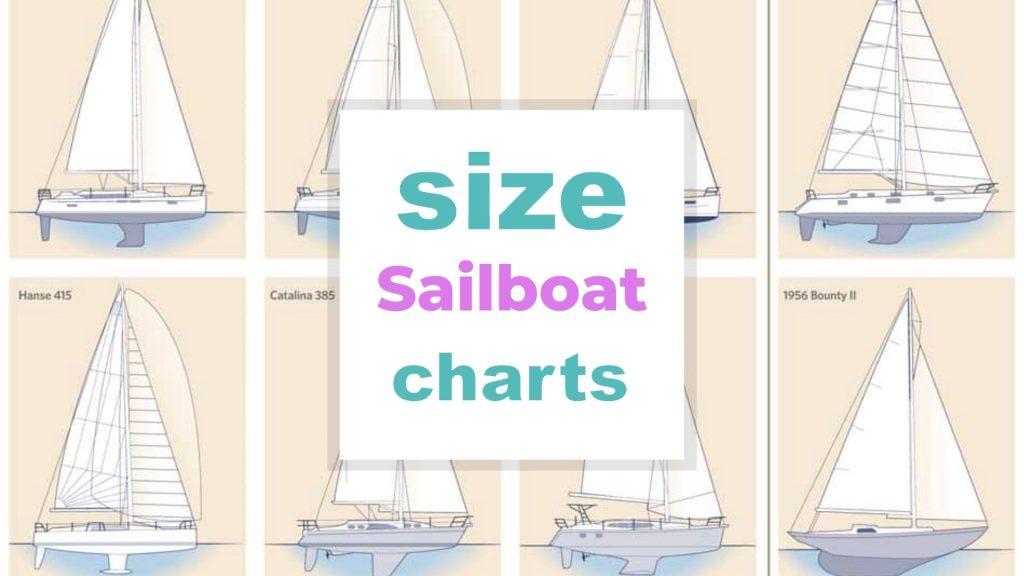
Sailboats are powered by wind, which is caught by the sails and used to push against the water. This action propels the boat forward. Sailboats can be sailed alone or with a crew, and they can be used for racing, cruising, or other activities.
This guide is not about sailboats though, but all about sailboat sizes. So let’s get right into it.
Jump right into the Frequently Asked Questions
Related: What Kite Size do I need for Kitesurfing? , Roller Skates Size: Find The Perfect Fit , Skateboard helmet size chart and fitting guide , Yoga Ball Size chart for exercising or for your office , Roller Skate Size Chart for Adults and Children , Printable Shoe Size Chart – How do i measure my foot size?
Sailboat Size Table of Contents
The importance of sailboat size, what is a good size for a sailboat, sailboat size chart (by sailing class), what is a good size sailboat for the ocean, frequently asked questions.
Related: Surfboard Size Guide and Dimensions
For those who love to sail, the sizing of the sailboat is critical. The process, though daunting, will turn out satisfying when you’re able to find a boat that’s most compatible with your needs.
There are different sailboat sizes curated for different situations such as the distance to be covered, the number of passengers, the budget, and preferences that come into play when looking out for a sailboat.
For whichever your needs, you want to end up with a vessel that’s going to assure you safety over the waters and at least remain within the sailing or cruising safety index. Hence, the begging question – how do you find a sailboat size that’s big enough without being too big?
We seek to answer all the whys and why-nots you might have regarding sailboat sizes. We also seek to make it easy for you to determine a vessel that you not only need but also one that’s in line with your taste.
Related: Jet Ski Size: Which Size Should You Go For?
A good sailboat is at least 30 ft. Such a boat is seaworthy, comfortable, and can be sailed on without breaking the bank. It is one of the smallest sail sizes that can go for long distances.
However, most sailors prefer between 35 and 45ft sailboat sizes. A good sailboat for your family should fall somewhere between 30 and 40ft.
A 30ft sailboat is as good as a 40ft and 50ft boat in many ways as long as comfort is overlooked. For its ability to go for very long distances, a 30-foot sailboat is one of the smallest sailboats that sail around the world.
However, Alessandro di Benedetto’s story of circumnavigating the world using his 21-foot sailboat says it all. He broke the world record for using the smallest yacht to sail around the world, showing that sailboats are more powerful than we know.
Learn more about how to pick the right size sailboat (video)
Related: Kayak Paddle Size by type and height (size charts included)
Related: Ski pole size advice with easy to use size charts
A 30-foot sailboat is a good place to start. This size is good enough to carry out the downwind sailing to the destination. The boat is also easy to manage during waves and has some room to store cargo and food in the event that the sailing takes days or weeks.
A 30-foot boat is among the smallest sailboats for ocean crossing because of the dire demands of long sails such as comfort and storage.
Moreover, the bigger the boat the faster the sails for its ability to tackle high waves, just to mention. The best size sailboat for ocean crossing ranges from 35 – 45ft.
Check out this video to learn more about sailboat sizes
What is the minimum size sailboat for open ocean sailing.
The 27-foot boat is the minimum sailboat to cross the Atlantic, according to the Atlantic Rally for Cruisers. While this site is not as popular as bigger boats of 38 feet, it is something you can bank on for open-ocean sailing on a budget.
Most people swear by bigger boats that will make it easier and less of a hassle to sail downwind.
Even smaller boats have managed to cross the Atlantic such as the renowned Tinkerbelle (13.5 foot). The boat soared into history books for being the world’s smallest sailboat to cross the Atlantic Ocean in 1965.
Is a 30-foot sailboat big?
A 30-foot sailboat is big enough for a couple setting out for a long distance. Many sailboat brands of this size make it comfortable for two people. The boat has a sleeping space, toilet, shower, food storage, sink, and stove that make it comfortable for two people.
In simple terms, the smaller the number of sailors the better the sailing experience on a 30-foot boat.
For instance, a 20ft sailing boat is big enough for one person but can also be used by a family of six, of course, depending on the brand and its sturdiness.
Can one person sail a 30-foot boat?
Yes, a 30-foot boat can be steered by one person. In such a scenario, it’s important to prep for the sail as much as possible as you will be forced to skip some activities.
With the right boat size, automation of systems that are in the best condition, enough sail area, and properly operating assistive equipment sailing a 30-foot boat can be less taxing than you think.
Several other factors come into play such as experience and physical fitness. A sailor may need to be agile and exploit their sailing skills especially when things go wrong.
Can you single-hand a 40-foot sailboat?
It is very possible to single-hand a 40-foot or even bigger sailboat. This calls for the right measures to be in place. If looking to sail solo, try going for shorter distances as you gain the courage and skills to manage the vessel above the waters for longer distances.
Otherwise, such a boat size can be challenging to single-hand if you’re doing it for the first time.
Moreover, ensure that the weight of the cargo is not beyond 90 tons, to make it easier to steer on high waves.
How many people can a 30-foot boat fit?
A 30-foot boat will accommodate a maximum of 11 passengers without any stability problems. However, this is advisable for short distances because of comfort issues.
The boat is among the smallest sailboats around the world as brands prefer bigger vessels, speaking of the growing demand for them today.
To determine a boat’s passenger capacity, multiply the length of the boat by its width then divide the product by 15. This is especially important if the boat lacks a capacity plate.
While different sailing yacht sizes have different sailing experiences, small doesn’t always mean incapable. Small boats are cheaper than big ones because of their speed and ease of steering during harsh weather conditions.
Solo sailing is not advisable for long sails because of the physical demands to steer the boat through to its destination.
Above all, sailboat size is an important consideration when purchasing a sailboat. The wrong size sailboat can lead to disappointment and wasted money. Please use this guide to be sure you are getting the right size for the purpose before you hit the waters.
Any questions? Well, we are always happy to help. So please use the comments area to share your questions.
Picture in this post is by Kristel Hayes on Unsplash
Related to Sailboat Size

Thomas Vandepitte 185 Posts
Leave a reply cancel reply.
Your email address will not be published. Required fields are marked *
Save my name, email, and website in this browser for the next time I comment.
Imagine a world with minimum to zero returns. Imagine a perfect fitting bought product. Our vision is to improve the online shopping experience by becoming the go-to source for accurate sizing tools and information, reducing returns, and increasing customer confidence and conversion rates.
Privacy Policy
The Partner network
Request or add a size chart
Wordpress plugin
Chat-GPT Size Advisory
Size Chart Search Engine
Size Charts by Brands
- Converse Size Charts
- Allbirds Size Charts
- Dr Martens Size Charts
- Hanks Size Charts
- Hermès Size Charts
- Veja Size Charts
- Lane Bryant Size Charts
- Diadora Size Charts
- Salvatore Ferragamo Size Chart
- Chanel Size Charts
- Levis Size chart
- Valentino Size Charts
- Moncler Size Charts
- Lee Size Charts
- Merrell Size Charts
- Diesel Size Charts
- Armani Size Charts
- Wrangler Size Charts
- Salomon Size Charts
- Miss Me Size Charts
Size Charts by Topics
- Insoles Size Chart
- Bookcase Size Charts
- Battery Size Chart
- Country size charts
- Bracelet Size Chart
- RV size Chart
- Rug Size chart
- Skateboard Size Chart
- Cap Size Chart
- Fitness Size Chart
- Music Size Chart
- Condom Size Chart
- Gun Size Chart
- Snow Size Chart
- Helmet Size Chart
- Diapers Size Charts
- Hats Size Chart
- Maternity Size Charts
- Gloves Size Chart
- Glasses Size Chart
Size Charts by Gender
- Men Size Charts
- Kids Size Charts
- Women Size Charts
Size Charts by Types
- Comfort Size Charts
- Dog Size Charts
- Fish Size Chart
- Gender Neutral Size Charts
- Golf Size Charts
- Horse Size Charts
- Luxury Size Charts
- Plus Size Charts
- Safety Size Charts
- Work Size Charts

What Size Sailboat Can One Person Handle?

Last Updated by
Daniel Wade
June 15, 2022
Getting the right size of boat for your sailing adventures will significantly impact your sense of security and safety, comfort, and your activities aboard the boat, especially if you're planning to embark on solo sailing. It's, therefore, of great importance to get it right from the start as it will save you time, disposal expenses, and determine whether or not you can sail solo.
Whether you're an introverted loner who loves going it alone or love the unique challenges that solo sailing presents, one of the most important questions that you've probably been asking yourself is; how big a sailboat can one person handle? In most cases, solo sailing will mean that you assume all the roles: bow-person, skipper, engineer, navigator, dial trimmer, and chef. Under such a scenario, the main intention is to make these roles as simple as possible for you and this calls for the right sized sailboat.
So how big a sailboat can one person handle? Well, a sailboat measuring between 35 and 45 feet (10.5 - 14 meters) with a draft of about 2 meters, plenty of sail area, easy reefing, and well-working assistive equipment can be ideal for one person to handle. The boat shouldn't be over 9 tons as things can get a little tricky and out of hand if the boat exceeds this weight. In essence, the boat should have automated systems that work properly including a properly working electric windlass that makes hauling an anchor as simple as possible.
In this article, we'll look at some of the reasons why sailboat measuring between 35 and 45 feet can be perfectly handled by one person.
Table of contents
Why 35 to 45 Feet?
Generally speaking, vessels that measure between 35 and 45 feet normally steer well and have a good sea-keeping ability. They usually have assisting self-steering arrangements, tolerable sailing speed, and good storage capabilities. Better still, such sailboats can be designed in such a way that a single person may perform all the sailing tasks completely unassisted.
Below the decks, these sailboats generally offer comfortable seagoing sleeping berths for one person, as well as additional space for the occasional guest. That's not all; the galleys are usually very workable and safe even for continuous use. The navigation station is independent, comfortable, and large enough so that you can lay the charts out flat and permanently. You also have additional storage that is perfect for additional charts.
One of the most overlooked factors when considering the ideal boat that can be perfectly handled by one person is the storage capability. If you're planning to sail single-handedly to far-flung areas, the boat should have a hoard of equipment. The boat should have fuel storage, a dinghy, oars, secondary chains, life jackets, anchor rods, EPIRBS, storm equipment, engine spares, additional batters, and many more. There should also be enough storage to accommodate food and water provisions for at least two months. With that in mind, 35-45 feet long sailboat should have enough storage space to accommodate everything that you need to sail perfectly, safely, and single-handedly.
Other Factors to Consider
While your physical strength, fitness, experience, determination, and nautical skills can impact the size of a sailboat that you can single-handedly handle with confidence, these are just a few definitive factors. As such, the size of the boat's sails will play a critical role. It doesn't matter how fit or strong you are, it's almost impossible to perfectly handle sails that measure 300-400 square feet on your own, and these are more common on vessels measuring 50-60 feet.
This is exactly why you shouldn't go for a sailboat that exceeds 46 feet if you're planning to sail single-handedly. You should refrain from going for a larger sailboat as it can be far trickier to dock in a crowded marina if you're sailing single-handedly. If anything, a boat measuring 35-45 feet will allow you to see around. It's also maneuverable, especially when anchoring and docking. You should also keep in mind that boats measuring 35-45 feet are generally designed with engine props, keels, and electric bow thrusters that can make a huge difference in the handling and maneuverability of such boats.
Here are a few factors to consider when looking at the size of a sailboat that you can handle on your own.
The anchor - Any sailor will tell you that it's always advisable to go out there on the water with an anchor that's large and strong enough to hold the sailboat safely in case there's a storm. But because you want a sailboat that you can handle on your own, you should ask yourself; can you raise the boat's anchor back to the deck with the help of a winch or another person? This should help you determine the size of a sailboat that you can handle alone.
Configuration of the Sailboat - This pretty much revolves around the maneuverability of the boat. Simply put, the sailboat should be designed in a way that you can single-handedly maneuver it to a dock even when strong winds are blowing. You should also be able to get a line from the sailboat to the dock without losing control of the boat.
You should also make sure that you can reef, lower, smother, and work with the sails in all kinds of weather without any assistance.
Hardware - Another important factor to consider when looking for the right size of a sailboat that you can handle alone is the hardware. Many equipment manufacturers now offer affordable hardware that can be used by lone sailors at the highest levels. For example, there are canting keels and roller furling headsails that are generally used in short-handed racing and these technologies have filtered into the mainstream.
There are also robust and reliable sailing handling systems such as electric winches, top-down spinnaker furlers, code zeros that can be of great help if you want to sail single-handedly, especially for offshore adventures. You can also go for reliable autopilots that are interfaced with wind instruments to enhance your safety and navigation. You can also use releasable inner forestay designed with hanks to make your headsail reef a lot easier. The boat should have enough reefs and the seat should have a comfortable cushion to make long hours of sailing more enjoyable.
Safety and communication - Sailing single-handedly always requires that you take your safety into serious consideration. You do not have a crew that will help you when there's a mishap so there's always an increased risk. For this reason, your safety and communication should be paramount if you're looking for a sailboat that you can handle alone. Some of the most important things to have in place include stout webbing straps that run from bow to stern and should be clipped into the tether on your harness. These are some of the safety devices that you should use even when the weather is very calm. You should also have an appropriate life jacket and wear it at all times.
That's not all; you should have a perfect sail and communication plan that you can share with a trusted contact on land. Of course, this should include your sailing route and projected timeline. You should have satellite phones and Wi-Fi onboard the boat, as well as other reliable communication devices. You should also have an extra battery. More importantly, you should attend safety as sea courses as this will enhance your skills of staying safe in case there's a mishap when sailing single-handedly.
Going Smaller than 35-45 Feet
As we noted earlier, a sailboat measuring between 35 and 45 feet is the sailing sweet spot if you want to sail single-handedly. This is because such sailboats do offer almost everything that you need to sail without any assistance. However, you may decide to go smaller but this would mean that the storage capabilities go against you.
In most cases, a sailboat measuring about 25 feet long would mean that you lose about 4 tons of storage space as well as the overall weight. This would mean that the boat is much lighter and this might affect your speed. Remember, the longer the boat, the faster the speed and this is essential for seagoing passages. On the other hand, a shorter boat will be slower and this means that you'll have to carry more food and water if you're going for offshore adventures.
As such, the volume of accommodation required may overwhelm a smaller vessel and this can make the operation of such a boat quite challenging. Other areas such as the navigation and galley table may be cramped and this can compromise the way you operate the boat. Worst still, the possibility of having a friend or a loved one join you aboard the boat is nearly impossible since there may be not enough accommodation for the two of you.
Another notable disadvantage of going smaller is the violent motion that it endures when sailing. This can be stressful and very likely to cause seasickness and this is something that you don't want when sailing single-handedly.
Going Larger than 35-45 Feet
If you're not on a limited budget, then you may choose to go for a sailboat that is larger than 35-45 feet. Larger sailboats are more speed and will always deliver sea-kind motion. You also have ample storage and accommodation for friends and family. But even with these advantages, the fundamental weakness of a larger sailboat is that it's almost impossible for one person to perfectly handle it. In other words, it's impossible to perfectly handle, maintain, and manage all facets of sailing a larger vessel. In fact, it can be even challenging or two people to handle it.
In essence, handling a larger vessel single-handedly can be brutal, to say the least. You may have lots of equipment but you'll still require more manpower to have them working appropriately.
To this end, it's easy to see why sailboats measuring 35-45 feet are the best for solo sailing . Smaller vessels might be ideal for the weekends but they are slower and do not have enough storage and accommodation space for offshore sailing. Almost similarly larger vessels (46 feet and above) are faster, beautiful, and spacious, but handling them on your own is almost impossible. So if you're looking for a sailboat that you can perfectly handle on your own, go for a vessel measuring between 35 and 45 feet long.
Related Articles
I've personally had thousands of questions about sailing and sailboats over the years. As I learn and experience sailing, and the community, I share the answers that work and make sense to me, here on Life of Sailing.
by this author

Most Recent

What Does "Sailing By The Lee" Mean?
October 3, 2023

The Best Sailing Schools And Programs: Reviews & Ratings
September 26, 2023
Important Legal Info
Lifeofsailing.com is a participant in the Amazon Services LLC Associates Program, an affiliate advertising program designed to provide a means for sites to earn advertising fees by advertising and linking to Amazon. This site also participates in other affiliate programs and is compensated for referring traffic and business to these companies.
Similar Posts

How To Choose The Right Sailing Instructor
August 16, 2023

Cost To Sail Around The World
May 16, 2023

Small Sailboat Sizes: A Complete Guide
October 30, 2022
Popular Posts

Best Liveaboard Catamaran Sailboats
December 28, 2023

Can a Novice Sail Around the World?
Elizabeth O'Malley

4 Best Electric Outboard Motors

How Long Did It Take The Vikings To Sail To England?

10 Best Sailboat Brands (And Why)
December 20, 2023

7 Best Places To Liveaboard A Sailboat
Get the best sailing content.
Top Rated Posts
Lifeofsailing.com is a participant in the Amazon Services LLC Associates Program, an affiliate advertising program designed to provide a means for sites to earn advertising fees by advertising and linking to Amazon. This site also participates in other affiliate programs and is compensated for referring traffic and business to these companies. (866) 342-SAIL
© 2024 Life of Sailing Email: [email protected] Address: 11816 Inwood Rd #3024 Dallas, TX 75244 Disclaimer Privacy Policy
What's the Right Size Sailboat for the Mediterranean Sea?
There's really no requirement in the Mediterranean Sea when it comes to the size of your sailboat. However, some marinas and ports in this area have limitations on the size of boats they can accommodate. With that, let me help you take into account marina slip size and other dimensional limitations on the European coast when choosing the right size sailboat for exploring the Med Sea.
Sailboats between 30 and 50 feet are commonly used for cruising and racing in the Mediterranean. Smaller sailboats can also be used, but are more limited in terms of their range and comfort. Meanwhile, larger sailboats may be more challenging to maneuver in some of the tighter spaces found in many Mediterranean ports.
Marina Agana in Croatia can only accommodate boats with a maximum length of 25 meters and drafts of up to 6 meters. If your sailboat exceeds these dimensions, you may need to find alternative marinas in the area. Let's find out more about this interesting fact.
- Port Vauban in France can accommodate boat lengths of up to 160 meters, while Port de Fontvieille in Monaco can only accommodate boat lengths of up to 30 meters.
- The recommended boat size in Croatia ranges from 30 to 40 feet, but in Greece, you can have sailboats as big as 50 feet.
- The European coast has several canals, bridges, and locks that have size restrictions, which can limit the maximum size of sailboats that can pass through these areas. Check the area where you will be passing and learn about certain boat size requirements.
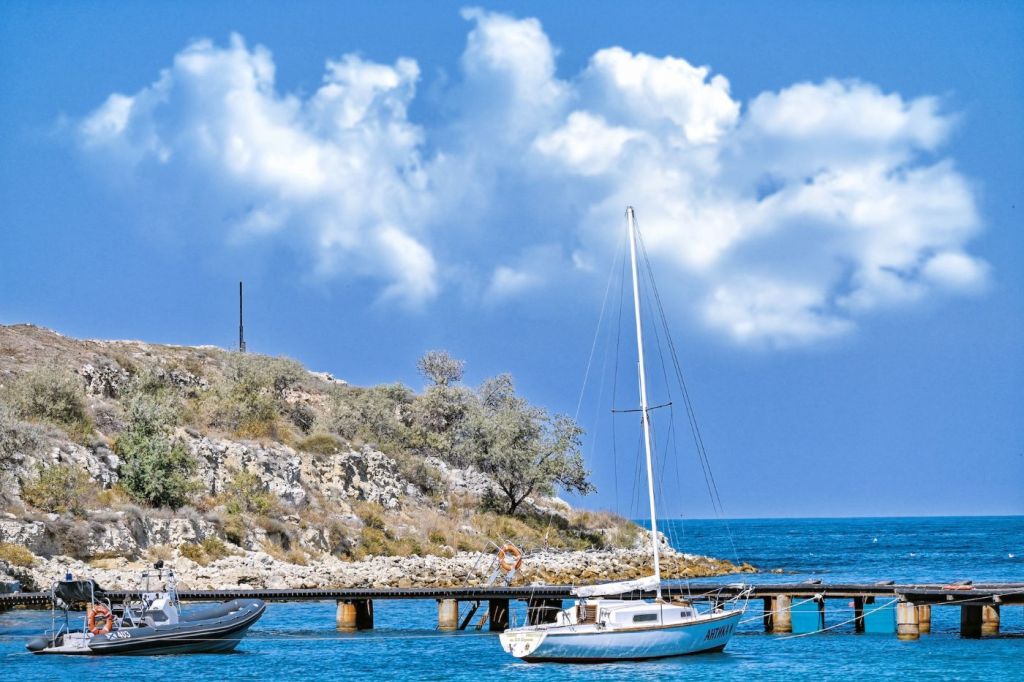
The Right Size of Sailboat in the Mediterranean Sea
Below is a table of some of the marinas in the Mediterranean Sea with their estimated maximum boat length size requirements:
The minimum and maximum size of sailboat suitable for sailing in the Mediterranean Sea can vary depending on factors such as the experience level of the sailors, the specific region of the Mediterranean, and the intended use of the sailboat.
However, generally speaking, sailboats between 30 and 50 feet in length are commonly used for cruising and racing in the Mediterranean. Smaller sailboats can also be used, but may be more limited in terms of their range and comfort, while larger sailboats may be more challenging to maneuver in some of the tighter spaces found in many Mediterranean ports.
But aside from the factors mentioned above, your choice in sailboat size can also be affected by dimensional limitation on the European coast, as well as the marina slip size.
The Right Size of Sailboat for Different Mediterranean Locations
Here are the right sizes of sailboat for different parts of the Mediterranean Sea.
Factor in dimensional limitations in the European coast
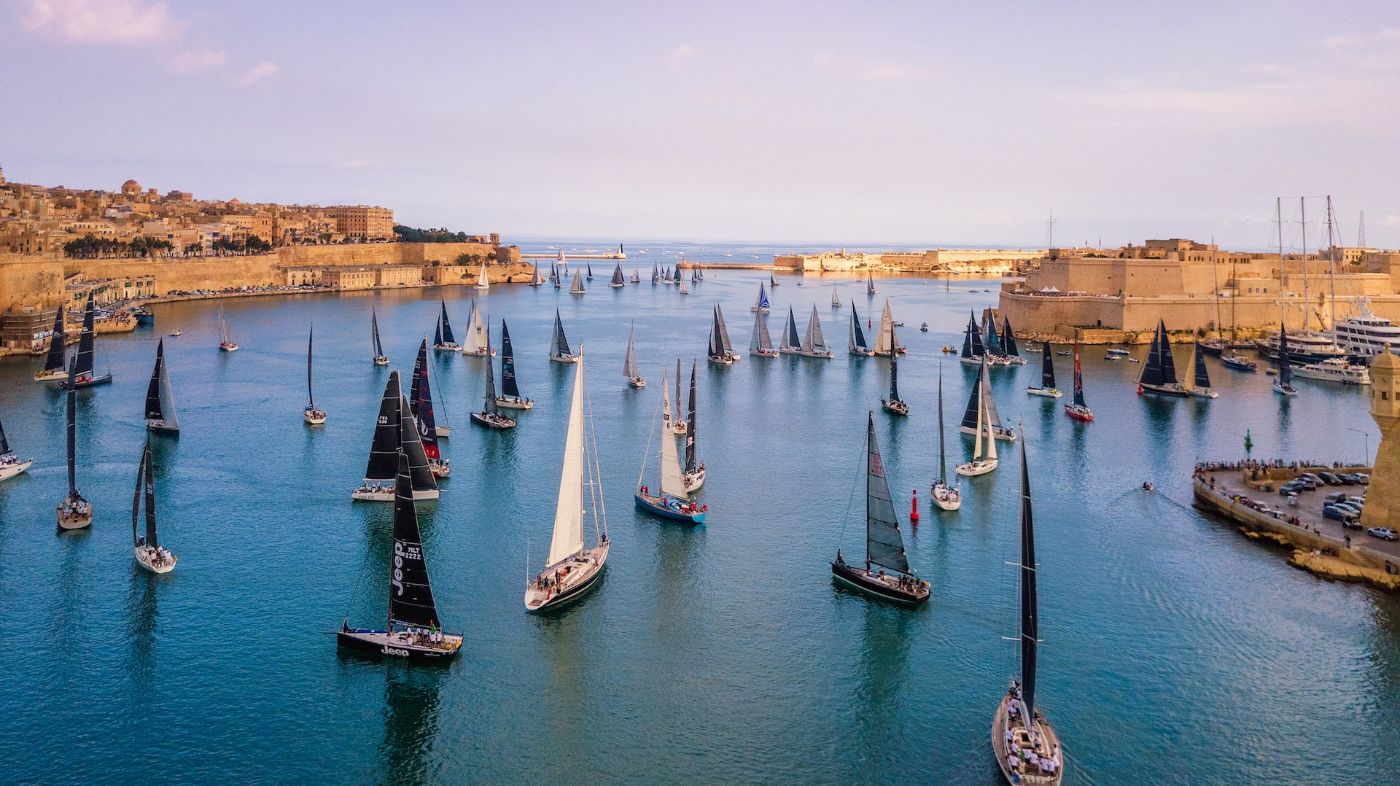
The European coast has several canals, bridges, and locks that have size restrictions, which can limit the maximum size of sailboats that can pass through these areas. This means that sailboats that are too large may not be able to access certain areas or may have to take longer routes to reach their destination, which may be inconvenient or impractical.
Below are some examples of dimensional limitations on the European coast that can affect your size choice of sailboats:
1. The maximum canal lock size in Canal du Midi in France is 30 meters
The Canal du Midi is a popular route for sailboats cruising in the Mediterranean. However, the canal has several locks with the following requirement:
- Maximum length: 30 meters
- Maximum width: 5.2 meters
- Maximum draft: 1.8 meters
Sailboats that exceed these dimensions may not be able to pass through the canal. If you want to learn more about the average canal lock sizes in other parts of Europe, you might want to read this article.
2. Restrictions in Venice, Italy
Venice has several canals and bridges that have size restrictions. The Rialto Bridge is one of the most famous bridges in Venice and has a central arch with a clearance height of 7.5 meters and a width of 22 meters.
Sailboats with a mast height greater than 7.5 meters may not be able to pass under the bridge, while sailboats with a beam width greater than 22 meters may not be able to pass through the central arch.
The Venice Grand Canal is the main waterway in Venice and has several bridges and narrow points that can limit the size of sailboats that can navigate through. Some of the narrower points on the canal have a width of just 5 meters, which can limit the size of sailboats that can pass through.
Additionally, some of the bridges on the canal have a clearance height of just 4 meters, which can limit the size of sailboats that can pass under them.
3. The French Riviera has several sailboat limitations
The French Riviera has several ports and marinas that have limited space and may not be able to accommodate larger sailboats. For example, the Port de Nice has a maximum length limit of 190 meters and a maximum draft limit of 6 meters.
4. The narrow path of the Strait of Gibraltar can be a limiting factor for sailboats
The Strait of Gibraltar is a narrow channel that connects the Mediterranean Sea to the Atlantic Ocean. The strait has a maximum width of 14.3 kilometers and a maximum depth of 900 meters. Sailboats that are too large may have difficulty navigating through the strait, especially during periods of strong currents or high winds.
Additionally, there are several shipping lanes in the strait that are used by large commercial vessels. Sailboats should be aware of these shipping lanes and take caution when navigating through the strait.
Consider the draft size and mast type of your sailboat
The draft refers to the depth of the boat's keel, which determines how close you can get to shore. In general, sailboats with a draft length of 6 feet or less are considered more suitable for sailing in the Mediterranean Sea. This is because many ports and harbors in the Mediterranean have shallow waters, and sailboats with a deeper draft may have difficulty accessing certain areas or may be limited in their ability to anchor in shallow waters.
Also, sailboats with a shallower draft tend to be more maneuverable and can navigate through narrow channels and shallow waters more easily. This can be particularly important in areas of the Mediterranean with strong currents or tidal changes.
The mast size is also important, as it determines the sail area and the boat's performance in different wind conditions. Most sailboats in the Mediterranean use either a masthead rig or a fractional rig.
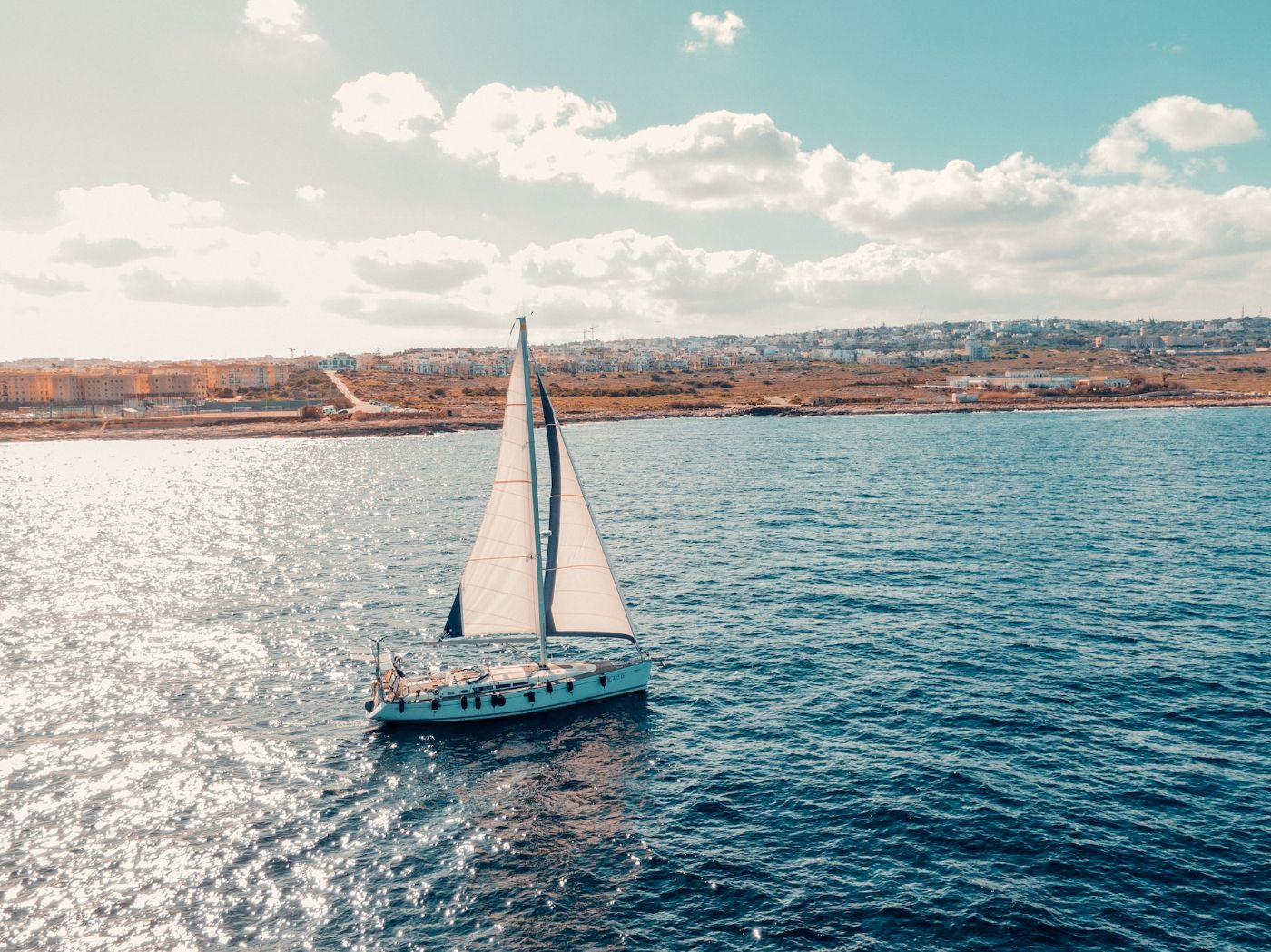
A masthead rig is a type of sailboat mast where the forestay attaches to the very top of the mast, while the backstay attaches to the stern of the boat. This type of rig is commonly used on larger sailboats and provides a more powerful sail plan for upwind sailing, making it a good choice for racing or cruising in the Mediterranean.
A fractional rig , on the other hand, is a type of sailboat mast where the forestay attaches to a point below the top of the mast, typically around two-thirds of the way up. This type of rig is commonly used on smaller sailboats and provides a more balanced sail plan, making it a good choice for cruising and day sailing in the Mediterranean.
An ultimate guide to rig types can be found in this article: Guide to Understanding Sail Rig Types (with Pictures)
The impact of marina slip size in choosing the right sailboat size
A marina slip that is too small for a sailboat can make docking and maneuvering difficult, while a slip that is too large can limit the number of available slips and may be more expensive to rent.
Additionally, the size of the marina slip can also impact the cost of docking and mooring fees. Larger sailboats typically require larger slips, which can be more expensive to rent. Therefore, choosing a sailboat size that fits comfortably in the available marina slips can help keep docking and mooring fees more affordable.
The cost of dry-docking a sailboat in some of the popular docking spots in the Meds can be found in this article.
Sailboats between 30-40 feet in length are perfect in exploring Croatia
Croatia is a popular sailing destination in the Mediterranean, known for its stunning coastline and crystal-clear waters. When sailing in Croatia, it is recommended to choose a sailboat that is between 30-40 feet in length. This size of sailboat is perfect for exploring the Dalmatian Coast, which is dotted with picturesque islands and charming coastal towns such as Dubrovnik, Korcula, and Ston.
Choose sailboats within 40-50 feet when sailing in Greece
Greece is another popular sailing destination in the Mediterranean, with its beautiful islands and clear blue waters. When sailing in Greece, the best recommended size of sailboat is between 40-50 feet in length.
This size is perfect for exploring the Saronic Gulf, which is home to some of the most popular islands such as Hydra, Poros, and Spetses. You can also explore the islands of Hvar, Mijet, and Brac with this size of sailboat.
Italy is best explored using sailboats with size ranging from 35-45 feet
Italy is a popular sailing destination in the Mediterranean, known for its stunning coastline, charming villages, and delicious cuisine. When sailing in Italy, try to choose a sailboat that is between 35-45 feet in length.
This size of sailboat is perfect for exploring the Amalfi Coast, which is home to some of the most picturesque towns such as Positano, Amalfi, and Ravello. You can also explore the beautiful Krka Falls and the islands of Portorosa and Procida with this size of sailboat.
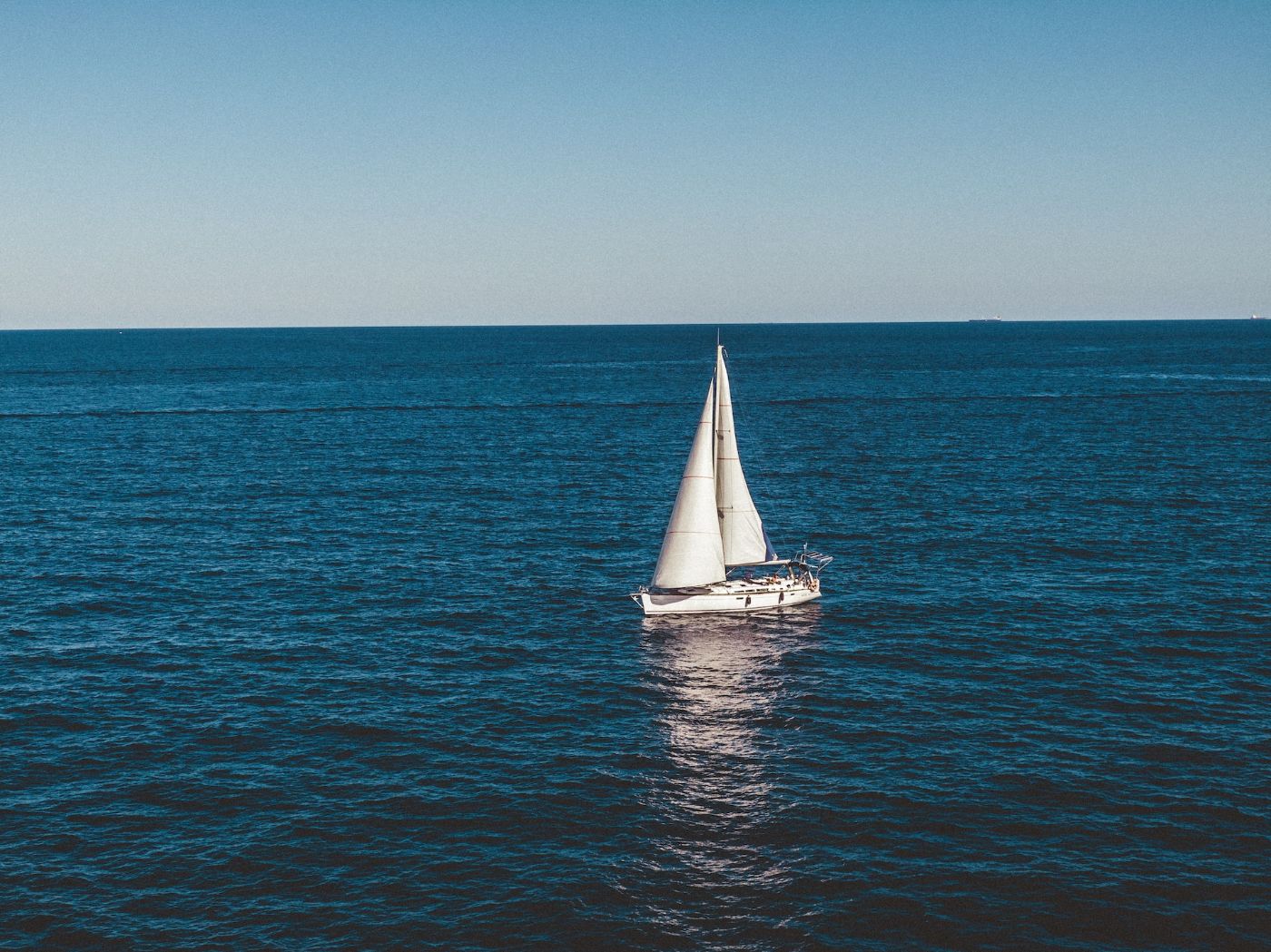
A 30-50-foot sailboat is best for exploring Turkey
Turkey has a long coastline with many sheltered bays and coves, making it an excellent destination for exploring by sailboat. The local weather conditions can be variable, with strong winds and choppy seas in some areas.
A sailboat with a length of 30-50 feet may be suitable for sailing in Turkey. This size sailboat provides good windward performance and a sturdy hull for navigating the strong winds and choppy seas in some areas.
A 35-50-foot sailboat is most suitable for sailing in Spain
Spain has a diverse coastline with many different sailing areas, including the Balearic Islands, the Costa Brava, and the Canary Islands. The local weather conditions can vary depending on the area, with strong winds and currents in some areas.
A sailboat with a length of 35-50 feet may be suitable for sailing in Spain. This size sailboat provides good maneuverability and a reliable engine for navigating the strong winds and currents in some areas.
Malta is best explored using sailboats with heights of 30-45 feet
Malta is a small island nation with a rich history and many ancient sites to explore. A sailboat with good cruising amenities and comfortable accommodations may be a good choice for sailing in Malta. Sailboats with lengths of 30-45 feet may be suitable for sailing in Malta.
Tunisia can be explored using a sailboat with a length of 30-50 feet
Tunisia has a long coastline with many sandy beaches and clear waters. The local weather conditions can be variable, with strong winds and choppy seas in some areas.
A sailboat with a length of 30-50 feet may be suitable for sailing in Tunisia. This size sailboat provides good windward performance and a sturdy hull for navigating the strong winds and choppy seas in some areas.
If you like to learn more tips for sailing in the Meds, you might want to read this article.
Leave a comment
You may also like, when is the mediterranean sailing season.
The Mediterranean has a unique climate and sailing conditions compared to other popular sailing destinations, such as the Caribbean and Atlantic. Let's find out in …
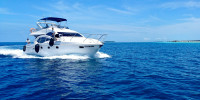
2023 Cost Of Mediterranean Yacht (As Seen On Below Deck)
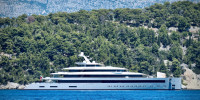
Cost to Rent a Mediterranean Superyacht: Less Than You Think
Own your first boat within a year on any budget.
A sailboat doesn't have to be expensive if you know what you're doing. If you want to learn how to make your sailing dream reality within a year, leave your email and I'll send you free updates . I don't like spam - I will only send helpful content.
Ready to Own Your First Boat?
Just tell us the best email address to send your tips to:
- Types of Sailboats
- Parts of a Sailboat
- Cruising Boats
- Small Sailboats
- Design Basics
- Sailboats under 30'
- Sailboats 30'-35
- Sailboats 35'-40'
- Sailboats 40'-45'
- Sailboats 45'-50'
- Sailboats 50'-55'
- Sailboats over 55'
- Masts & Spars
- Knots, Bends & Hitches
- The 12v Energy Equation
- Electronics & Instrumentation
- Build Your Own Boat
- Buying a Used Boat
- Choosing Accessories
- Living on a Boat
- Cruising Offshore
- Sailing in the Caribbean
- Anchoring Skills
- Sailing Authors & Their Writings
- Mary's Journal
- Nautical Terms
- Cruising Sailboats for Sale
- List your Boat for Sale Here!
- Used Sailing Equipment for Sale
- Sell Your Unwanted Gear
- Sailing eBooks: Download them here!
- Your Sailboats
- Your Sailing Stories
- Your Fishing Stories
- Advertising
- What's New?
- Chartering a Sailboat
- Sail Dimensions
What Sail Dimensions are Required to Calculate Sail Areas?
The required sail dimensions for calculating the area of any triangular sails are usually its height and the length of its foot. But that only works for mainsails and mizzens with no roach, and jibs with a 90 degree angle at the clew - and what about high-cut headsails, spinakers and cruising chutes? Read on...
Foresail and mainsail dimensions are universally referenced with the letters 'J', 'I', 'E' and 'P' approximating to the length of the foredeck, height of the mast, length of the boom and the height of the main sail - but more accurately defined further down this page.
Yacht designers need these sail dimensions to calculate thought provoking stuff such as the sail-area/displacement ratios of their creations, and sailmakers need them before they put scissors to sailcloth.
If our sailboat's sails were perfectly triangular then, as every schoolboy knows, their area would be 'half the height, times the base' - but with the possible exception of a mainsail with a straight luff, generally they're not. Here's how it works...
Main and Mizzen Sail Dimensions
These are almost right-angled triangles except for the curvature of the leach (the 'roach') which increases the sail area.
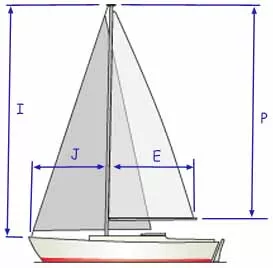
It's usually calculated as:~
Area = (luff x foot)/1.8, or
Area = ( P x E )/1.8, where:~
- 'P' is the distance along the aft face of the mast from the top of the boom to the highest point that the mainsail can be hoisted, and
- 'E' is the distance along the boom from the aft face of the mast to the outermost point on the boom to which the main can be pulled.
For the mizzen sails on ketches and yawls , 'P' and 'E' relate to the mizzen mast and boom.
For more heavily roached sails, the increased area can be accounted for by reducing the denominator in the formula to 1.6.
Clearly calculating sail areas isn't going to be an exact science...
Jibs, Genoas and Staysail Dimensions
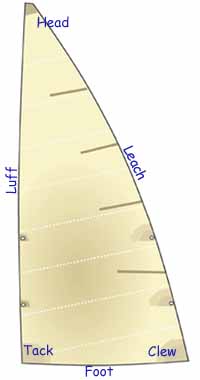
For a working jib that fills the fore triangle - but no more - and with a foot that's parallel to the deck, then you've got a 'proper' right-angled triangular sail, whose area is:~
Area = (luff x foot)/2, or
Area = ( I x J )/2, where:~
- 'I' is the distance down the front of mast from the genoa halyard to the level of the main deck, and
- 'J' is the distance along the deck from the headstay pin to the front of the mast.
Genoas, by definition, have a clew which extends past the mast and are described by the amount by which they do so. For instance a 135% genoa has a foot 35% longer than 'J' and a 155% genoa 55% longer. Areas are calculated as follows:~
Area (135% genoa) = (1.44 x I x J )/2, and
Area (155% genoa) = (1.65 x I x J )/2
High-cut Headsails
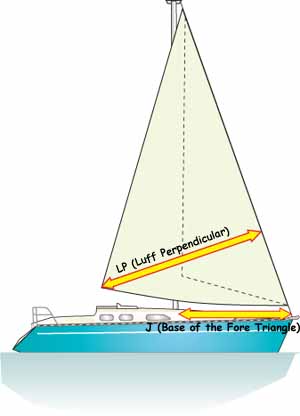
But these formulae don't work for a high-cut jib with a raised clew - unless you imagine the sail turned on its side such that the luff is the base and the luff perpendicular is the height.
It's still a simple calculation though, once you know the length of the luff perpendicular ( LP ), the sail area is:~
Area = (luff x luff perpendicular)/2, or
Area = ( L x LP )/2, where:~
- 'L' is the distance along the forestay from the headstay pin to the front of the mast, and
- 'LP' is the shortest distance between the clew and the luff of the genoa.
Spinnaker Sail Dimensions
Much like calculating foresail areas, but with different multipliers for conventional spinnakers and asymmetric spinnakers...
Conventional Spinnakers
Area = (0.9 x luff x foot), or
Area = (0.9 x I x J ), where:~
- 'I' is the distance from the highest spinnaker halyard to the deck, and
- 'J' is the length of the spinnaker pole.
Asymmetric Spinnakers
Area = (0.8 x luff x foot), or
Area = (0.8 x I x J ), where:~
- 'I' is the distance from the highest spinnaker halyard to the deck, and
- 'J' is the distance from the front face of the mast to the attachment block for the tackline.
More about Sails...
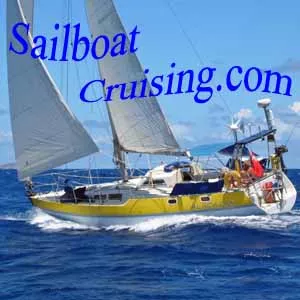
Are Molded and Laminate Sails One Step Too Far for Cruising Sailors?
Although woven sails are the popular choice of most cruising sailors, laminate sails and molded sails are the way to go for top performance. But how long can you expect them to last?
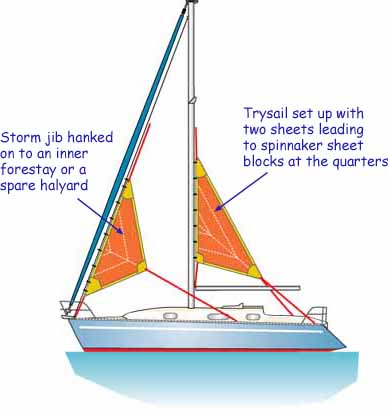
Is Carrying Storm Sails on Your Cruising Boat Really Necessary?
It's good insurance to have storm sails available in your sail locker if you are going offshore, and these are recommended fabric weights and dimensions for the storm jib and trysail
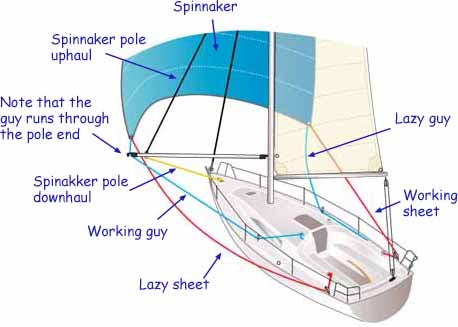
Using Spinnaker Sails for Cruising without the Drama!
When the wind moves aft and the lightweight genoa collapses, you need one of the spinnaker sails. But which one; conventional or asymmetric? Star cut, radial head or tri-radial?

The Mainsail on a Sailboat Is a Powerful Beast and Must Be Controlled
Learn how to hoist the mainsail, jibe it, tack it, trim it, reef it and control it with the main halyard, the outhaul, the mainsheet and the kicker.

Is Dacron Sail Cloth Good Enough for Your Standard Cruising Sails?
Whilst Dacron sail cloth is the least expensive woven fabric for standard cruising sails, do the superior qualities of the more hi-tech fabrics represent better value for money?
Recent Articles
Wauquiez Gladiateur 33 for Sale
Apr 10, 24 05:40 AM
'Cabo Frio', a Catalina Morgan 43 for sale
Apr 01, 24 08:35 AM
Live Aboard Boats For Sale
Mar 30, 24 07:02 PM
Here's where to:
- Find Used Sailboats for Sale...
- Find Used Sailing Gear for Sale...
- List your Sailboat for Sale...
- List your Used Sailing Gear...
Our eBooks...

A few of our Most Popular Pages...

Copyright © 2024 Dick McClary Sailboat-Cruising.com
- New Sailboats
- Sailboats 21-30ft
- Sailboats 31-35ft
- Sailboats 36-40ft
- Sailboats Over 40ft
- Sailboats Under 21feet
- used_sailboats
- Apps and Computer Programs
- Communications
- Fishfinders
- Handheld Electronics
- Plotters MFDS Rradar
- Wind, Speed & Depth Instruments
- Anchoring Mooring
- Running Rigging
- Sails Canvas
- Standing Rigging
- Diesel Engines
- Off Grid Energy
- Cleaning Waxing
- DIY Projects
- Repair, Tools & Materials
- Spare Parts
- Tools & Gadgets
- Cabin Comfort
- Ventilation
- Footwear Apparel
- Foul Weather Gear
- Mailport & PS Advisor
- Inside Practical Sailor Blog
- Activate My Web Access
- Reset Password
- Customer Service

- Free Newsletter

What You Can Learn on a Quick Test Sail

Cabo Rico’s Classic Cutter

Bob Perrys Salty Tayana 37-Footer Boat Review

Tartan 30: An Affordable Classic

Preparing Yourself for Solo Sailing

Your New Feature-Packed VHF Radio

Preparing A Boat to Sail Solo

Solar Panels: Go Rigid If You have the Space…

When Should We Retire Dyneema Stays and Running Rigging?

Rethinking MOB Prevention

Top-notch Wind Indicators

The Everlasting Multihull Trampoline

Taking Care of Your 12-Volt Lead-Acid Battery Bank

Hassle-free Pumpouts

What Your Boat and the Baltimore Super Container Ship May Have…

Check Your Shorepower System for Hidden Dangers

Waste Not is the Rule. But How Do We Get There?

How to Handle the Head

The Day Sailor’s First-Aid Kit

Choosing and Securing Seat Cushions

How to Select Crew for a Passage or Delivery

Re-sealing the Seams on Waterproof Fabrics

Waxing and Polishing Your Boat

Reducing Engine Room Noise

Tricks and Tips to Forming Do-it-yourself Rigging Terminals

Marine Toilet Maintenance Tips

Learning to Live with Plastic Boat Bits
- Sails, Rigging & Deck Gear
Selecting the Right Anchor Size
Holding power increases with weight, but how much is hard to calculate..
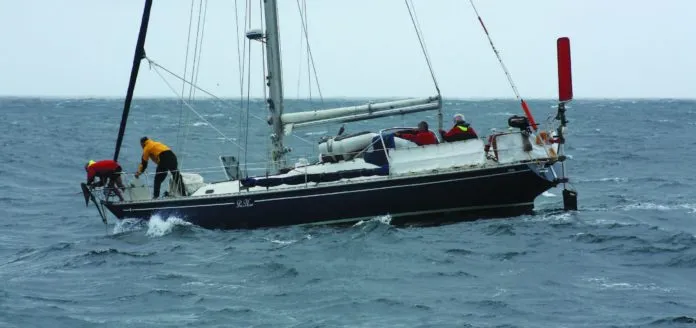
Over the years Practical Sailor has conducted dozens of anchor tests, and like many publications, we’ve repeated the common guidance that cruising sailors should buy an anchor that is at least one size larger than what the maker recommends for your size vessel.
During the last two decades, however, the tremendous holding power of some newer generation anchors have caused us to re-think this guidance. Are we paying more for an anchor, rode, and the requisite anchor handling equipment than we need? How accurate are the makers size recommendations? How much insurance are we really getting for the price of a bigger anchor?
For this report we took a range of modern, sometimes called new generation anchors, and their predecessors and averaged their weight vs. vessel size recommendations (see accompanying table). Much to our surprise, the weight recommendations for the new designs, Rocna, Excel, Supreme, etc. are very similar to the weight recommendation for the older, traditional models, CQR, Delta, Bruce etc. In both cases, the recommendation for a 35-foot yacht is approximately a 30-pound anchor. The exceptions are aluminum anchors from Fortress and Spade.
Most of the new generation anchors have been tested to international standards established by the RINA (Registro Italian Naval) or some other internationally recognized society. Rocna, Fortress, Supreme, Excel, Spade have been found to meet standards of Super High Holding Power, SHHP. The older anchors, CQR, Bruce, Delta are rated as High Holding Power. The difference between the two categories is that the SHHP have been tested and found to have a hold, comparing anchors of the same weight, that is two times that of the HHP anchors.
So if we’re getting double the holding power, does that mean we can use an anchor that is half the weight? Not necessarily. Nor can you expect another doubling of holding power by doubling the weight of an SHHP anchor.
Despite the sales pitch that the new anchors have greater holding capacity pound-for-pound, the anchor makers are suggesting that you replace your old CQR with the same weight new anchor. It appears that manufacturers are, in effect, doubling the historic safety factor. And for a cautious sailor, there is nothing wrong with this.
However, consider the advice that is often repeated on internet forums, or the local scuttlebutt, that cruising sailors should increase one size over the makers recommendation. So instead of a 33-pound Rocna for your Tartan 37, you buy a 44-pound Rocna-now with potentially three times the safety factor of an old school anchor. Apart from the added significant expense, this obsession with upsizing – more anchor, more chain, bigger windlass-can also add potentially unnecessary weight and concentrate it in the bow.
So what do we really get with that bigger anchor? There is an idea that if you double weight of an anchor you will double holding power. Except with extra-large commercial anchors and some specific tests, we’ve found no data to support this.
No independent test, as far as we know, has taken a series of different sized anchors of the same design and tested them in the same seabed for ultimate holding capacity. Tests have been conducted on commercial oil rig anchors like the Bruce, and the best scaling is about 90 percent-double weight and you increase hold by 1.8 times.
The only recreational anchor that we are aware of that has undergone some testing to determine the relationship between weight and holding is Fortress (in mud only, see Anchoring in Squishy Bottoms, PS February 2015 ). An analysis of all their tests on a complete range of their anchor sizes suggest that if you triple weight you increase hold by slightly more than two times, approximately an 80 percent efficiency as size is scaled up.
Ultimately, this means that when someone tells you they can calculate the increase in holding power as you move up in size, be careful not to read too much into this conclusion. For one, the ratio used deserves close scrutiny. Surely, the bigger anchor will provide better holding-but how much? This hard to quantify, even with computer modeling. And no matter how accurate your calculation-a ratio based on performance in one type of bottom might not apply in another.
One reason you can’t claim that doubling the weight doubles the holding is that as anchors increase in size, the stress on the construction increases. To compensate for the increase in stress, the steel thicknesses must be increased – and more steel weighs more. So in an anchor whose holding power relies greatly on surface area and how it is distributed, adding more weight doesn’t necessarily result in a commensurate increase in surface area that provides holding power.
And as we’ve shown in our past tests-anchor dimensions (especially the fluke area) and shape can play a significant role in performance. It might be possible to double weight and double the holding power without beefing up the steel, but the resulting anchor would be less strong relative to its designed holding power.
Weaker construction might not matter on an over-engineered anchor. However, we have seen how the use of inferior materials has resulted in anchors that bend more easily at designed loads (see Anchor Tests: Bending More Shanks, PS May 2013 ).
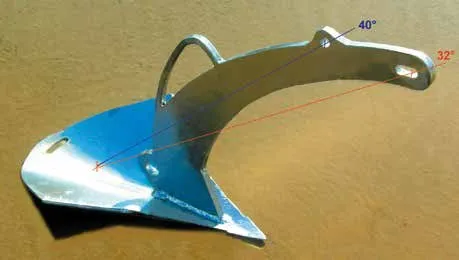
Anchor Angles
In past reports, we’ve discussed in detail how anchor design can impact holding, especially with the new generation anchors ( see An Inquiry into Anchor Angles, PS February 2017 ). As you consider which design best suits your needs, here are some things to consider.
Fluke/shank angle. The fluke/shank angle is the angle between fluke and shank. It is one of the determining factors in how quickly and deeply an anchor sets. For a simple design with flat plate fluke and a straight shank (like a Guardian) the angle is a line down the center of the shank to the hinge and then along the fluke. In shanks with curves or angles, the first line is usually drawn from the shackle pin to the point there the shank meets the fluke.
For three-dimensional flukes (as found in most new generation anchors), you have to estimate where the top of the fluke plate lies. The ballast chamber or shank support that might protrude from the sole, such as with Spade, or Vulcan anchor should not be used to determine shank/fluke angle.
It is the fluke top surface that is important. In previous tests we reported that in thin mud an anchor with a fluke angle of around 45 degrees will outperform an identical anchor with its fluke angle set at 30 degrees. But a firmer sand seabed is entirely different, and research demonstrates the ideal fluke angle for a typical sand bottom is around 30 degrees (see Small Anchor Reset Tests, PS February 2013 ).
Fluke-seabed angle. This is the angle of the fluke to the seabed during the phases of anchoring-most importantly, during the initial penetration into the bottom, and when the anchor is set.
Penetration angle. When an anchor is aligned ready to set, or engage with the seabed (it might need tension on the rode to achieve this) then the fluke will usually be at an angle of 60-70 degrees to the seabed. Commonly the anchor is on its side.
Setting angle. Once the anchor starts to penetrate it will self align and the fluke plate tend quickly toward its setting angle, usually of about 30 degrees. It is coincidence that the fluke/shank angle and setting angle are similar though most anchors tend to show the similarity of the two angles. Center of gravity can have a great effect on penetration angle. This is why many new generation anchors, like the Ultra, have weighted flukes. Having a 30-degree fluke/shank angle is irrelevant if the center of gravity is in the wrong place.
Shank length
If you imagine a Fortress with a shank/fluke angle of 30 degrees but a shank three times longer than its original design, then you can visualize how the anchor will probably simply slide along the seabed when tensioned. The throat opening will be too small. Similarly if you chop the shank in half, the toe of the anchor will simply scrape along the seabed. In both case the anchor will find difficulty in engaging because the penetration angle will be wrong.
Are the makers of new generation anchors over-stating the need for bigger anchors, thus requiring boat owners to pay much more than they might need in order to be secure at anchor? Possibly. Would going with a larger-than-required anchor actually hurt your anchors performance? Unlikely. As is often the case with our anchor reports, it is hard to come with some firm answers regarding both of these questions. Anchor studies are fraught with variables.
In our view, it is no crime to go up one size over the manufacturers recommended size, if your boat and crew can handle it. The anchor may require more reverse throttle to set, but ultimately, it should provide the holding you require. Likewise, it is reasonable to assume that the anchor makers guidance for sizing is reasonable. However, if an online advocate starts telling you that youll get x times more holding power by going up one size, ask him for the data.
Extra weight in an anchor is your insurance policy. Yes, you can almost always get more security with the heavier anchor, but whether or not you will every need that extra holding power is not conclusive. In our view, conservative sizing is added insurance-but until the data is in, we remain skeptical of any absolute claims that attempt to quantify the advantages of more weight when choosing an anchor.
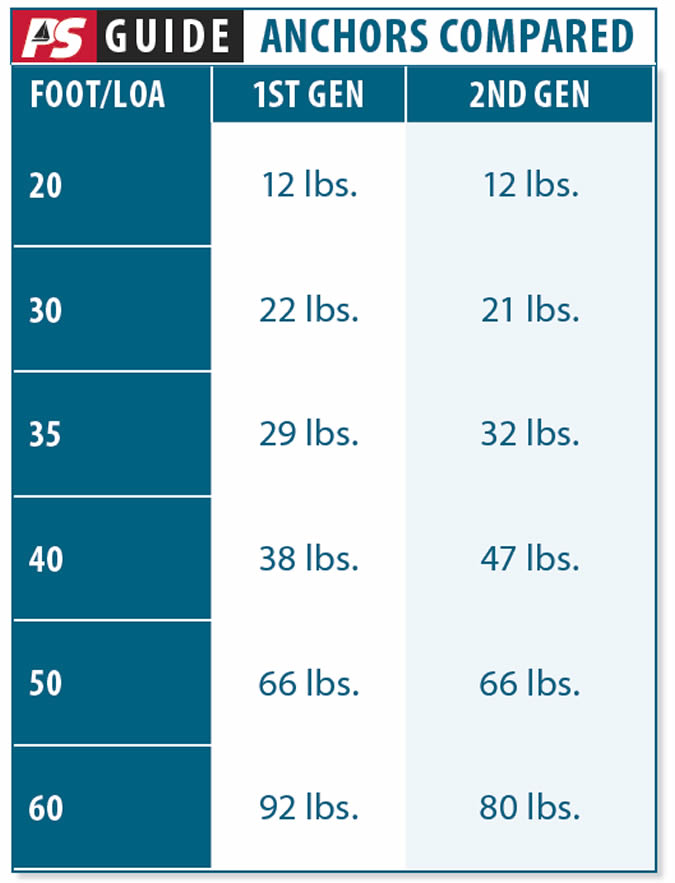
Based on average recommendations from leading anchor makers, the weight savings of upgrading to a second generation anchor doesn’t really pay off until you get into the larger size vessels.
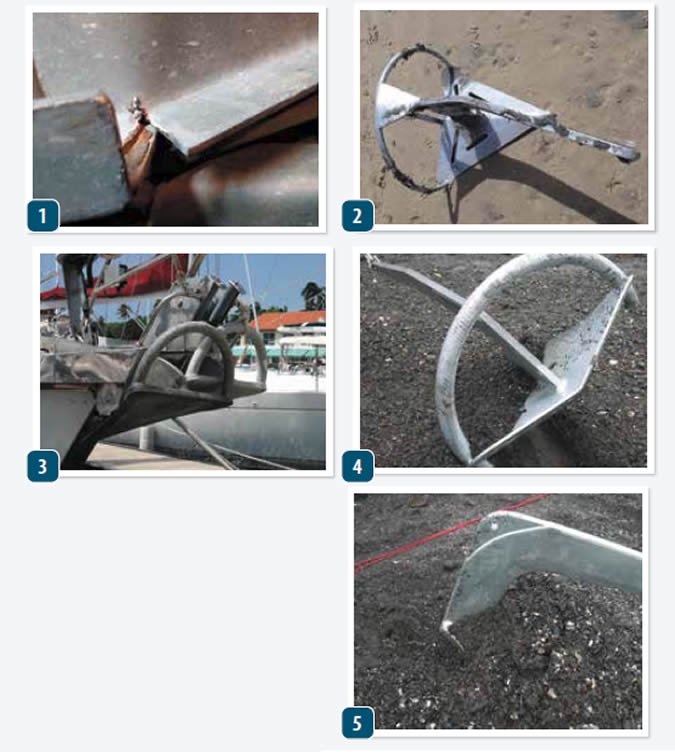
In an anchor whose holding power relies greatly on surface area and how it is distributed, adding more weight doesn’t necessarily result in a commensurate increase in surface area that provides holding power. To compensate for the higher loads, the steel must be thicker, resulting in different surface area/weight ratios.
- As fluke size increases, so do the loads. But if the construction isn’t beefed up to handle the loads, the result is failure. Flat plate steel in this Danforth fluke sheered.
- The shaft of an Excel anchor bent during veer testing.
- The flat flukes of the Bugel anchor makes it easy to calculate the shank-fluke angle.
- Here a Rocna anchor is in the initial setting angle, still capsized on one side, with not enough of its toe is dug into the soil to dig in. Bottom shape and center of gravity (some designs are weighted to control CG), helps to determine this angle.
- This Manson Ray anchor has rolled upright and assumed the angle of penetration that will help the anchor to bury into the bottom.
RELATED ARTICLES MORE FROM AUTHOR
Leave a reply cancel reply.
Log in to leave a comment
Latest Videos
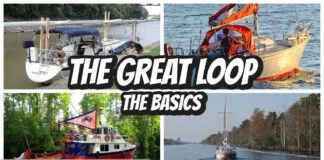
The Great Loop – The Basics

Bottom Paint Showdown – Six Paints, One Winner!

Tartan 30 | Boat Review

Fuel Contamination? The Baltimore Francis Key Bridge Collapse
- Privacy Policy
- Do Not Sell My Personal Information
- Online Account Activation
- Privacy Manager

IMAGES
VIDEO
COMMENTS
Factors to Consider When Choosing a Sailboat Size. When determining the right size of sailboat for your needs, there are several factors to consider. These include your budget, sailing experience, intended use, number of crew members, comfort and amenities, and storage and maintenance requirements.
Although there is no one right style or size of boat that will please everyone, here are a few common denominators that every perspective boat buyer will want to consider. ... The majority of cruising boats are in the 35-45-foot range but that doesn't mean you can't cross oceans, comfortably and safely in a 24-footer. ...
Here's How to Choose What Size Sailboat you Need: Consider your needs before buying your boat. If you are a solo sailor or have a huge family, if you cruise or race, or if you want to sail the ocean, your needs and size of the boat will change. Most sailboats range between 15-40 feet. Depending on your needs, you may need 15-25 or 25-40 feet.
Summary. For solo cruising, the best sailboat size is around 24 to 30 feet. If you're with your family or friends, opt for sailboats with a 35 to 45-foot range. The Sun Odyssey 349 is one of the most notable and multi-awarded cruisers due to its innovative design and exceptional performance.
Sailboats come in every shape and size, from single-person Opti sailing dinghies to the largest in the world, the Sailing Yacht A, at 142.8 meters (468.5 feet). Sailboats are generally measured by either their length overall (LOA) or length on deck (LOD).
In English: take the boat's gross displacement in pounds, divide it by 64 and then take the cube root of the quotient. Now, divide the boat's maximum beam in feet by the cube root figure. The resulting number should be 2 or less. In general, if the number is over 2, the boat fails the screen.
Average Sailboat Size. American sailboats come in all shapes and sizes, from tiny inflatable 12-foot dinghies to enormous 150-foot mega yachts. The average sailboat size in the United States is about 30 to 35 feet overall in length. These vessels are usually classified as 'coastal cruisers,' as they're seaworthy enough for limited offshore use.
The best size cruising sailboat. The best size cruising sailboat is in the range of 40 to 50 feet. Sailboats in this size range are large enough to provide comfortable accommodations for an extended period of time at sea, yet small enough to be easily handled by a small crew or even single-handed.
The first factor to consider when it comes to choosing a cruising sailboat is the size. When it comes to boats, it turns out, size does matter, both in terms of getting more speed and better stability, which are two of the basic requirements of a cruising sailboat. One of the reasons for this is that you need to be comfortable when you are ...
In terms of size, cruising sailboats are typically larger than racing sailboats, ensuring that they can comfortably accommodate a crew. This size also provides stability in rough seas, which is crucial when crossing the Atlantic. Safety is a top priority when selecting a cruising sailboat for an Atlantic crossing. These sailboats are ...
These vessels are minimally capable of coastal cruising. That said, this is the size range where the smallest practical offshore cruising vessels live. Famous compact blue water cruisers like the Flicka 20, Amigo 22, and the Dana 24 are capable and fall well within the coastal cruiser length category. Average Cruising Sailboat Length
The Corbin 39 is a beautiful blue water sailboat. It is a very rare boat with a proud history. Only a handful of these boats were finished to completion in the factory, the majority were sold as kits and built by the boat's owner. Because of this method of production, this model can vary drastically on the inside.
The Tayana 37 is a typical offshore cruising sailboat from the 1970's. Hey, you can catch your own fish, make your own drinking water from seawate r (or collect nature's free offering with a raincatcher) and charge your batteries with a windcharger or solar panels - all without using a drop of fuel!
During and in the four days immediately following the US Sailboat show in Annapolis, Maryland, the Cruising World judges inspected and sailed on 27 boats vying for recognition.Learn more about the boats in our 2022 Boat of the Year » Once upon a time, midsize cruisers, 30 to 40 feet, dominated the market, and harbors across the US were filled with what were once considered to be "big ...
The size of the sail area determines the boat's power and speed. It is essential to strike a balance between sail area and boat size to ensure safety and stability. For smaller sailboats (10-15 feet), it is recommended to have a sail area of 50-100 square feet, which is approximately 6-7% of the boat's displacement.
It is one of the smallest sail sizes that can go for long distances. However, most sailors prefer between 35 and 45ft sailboat sizes. A good sailboat for your family should fall somewhere between 30 and 40ft. A 30ft sailboat is as good as a 40ft and 50ft boat in many ways as long as comfort is overlooked. For its ability to go for very long ...
Jeanneau's new 2022 Sun Odyssey 380 sail boat is a bluewater cruising capable vessel with a base price of $237,000 that is on a short list candidate for couples and families looking to escape onto the water for day sails or extended coastal cruising. Above: A 2022 Jeanneau Sun Odyssey 380 Sailboat. Photo by Jeanneau.
For almost 20 years, we've called this awards program SAIL Best Boats, but this year, we're refining and renaming this program to better and more fairly represent the boats we've selected. Restricting boats to categories and labels—such as Best Cruising Monohull 30-40 feet and Best Performance Monohull 40-50 feet—doesn't bring our readers the full picture.
Well, a sailboat measuring between 35 and 45 feet (10.5 - 14 meters) with a draft of about 2 meters, plenty of sail area, easy reefing, and well-working assistive equipment can be ideal for one person to handle. The boat shouldn't be over 9 tons as things can get a little tricky and out of hand if the boat exceeds this weight.
Small cruising sailboats need to have a solid construction that will withstand the test of storms, tall waves and strong winds. ... offers a nice extra perk. According to Jack Hornon, she "continues to have one of the highest resale values of any boat of this type and size." A quick look at Yacht World reveals Baba 30s from the mid-70s and ...
The minimum and maximum size of sailboat suitable for sailing in the Mediterranean Sea can vary depending on factors such as the experience level of the sailors, the specific region of the Mediterranean, and the intended use of the sailboat. However, generally speaking, sailboats between 30 and 50 feet in length are commonly used for cruising ...
Primary dimensions for calculating areas of triangular sails. It's usually calculated as:~. Area = (luff x foot)/1.8, or. Area = ( P x E )/1.8, where:~. 'P' is the distance along the aft face of the mast from the top of the boom to the highest point that the mainsail can be hoisted, and. 'E' is the distance along the boom from the aft face of ...
However, consider the advice that is often repeated on internet forums, or the local scuttlebutt, that cruising sailors should increase one size over the makers recommendation. So instead of a 33-pound Rocna for your Tartan 37, you buy a 44-pound Rocna-now with potentially three times the safety factor of an old school anchor.